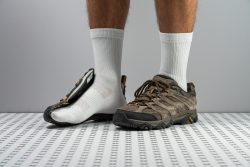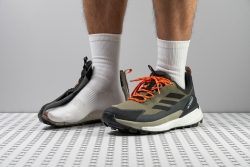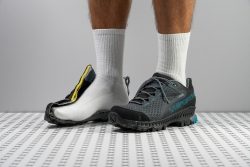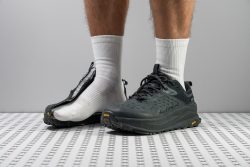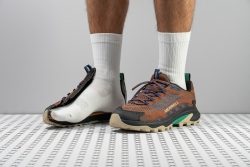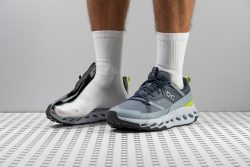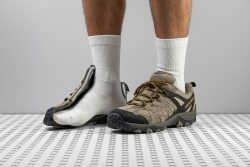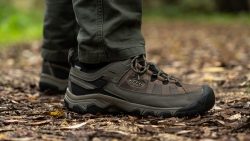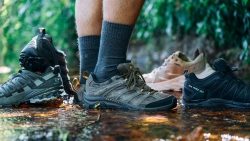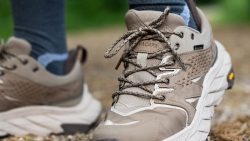7 Best Hiking Shoes in 2025
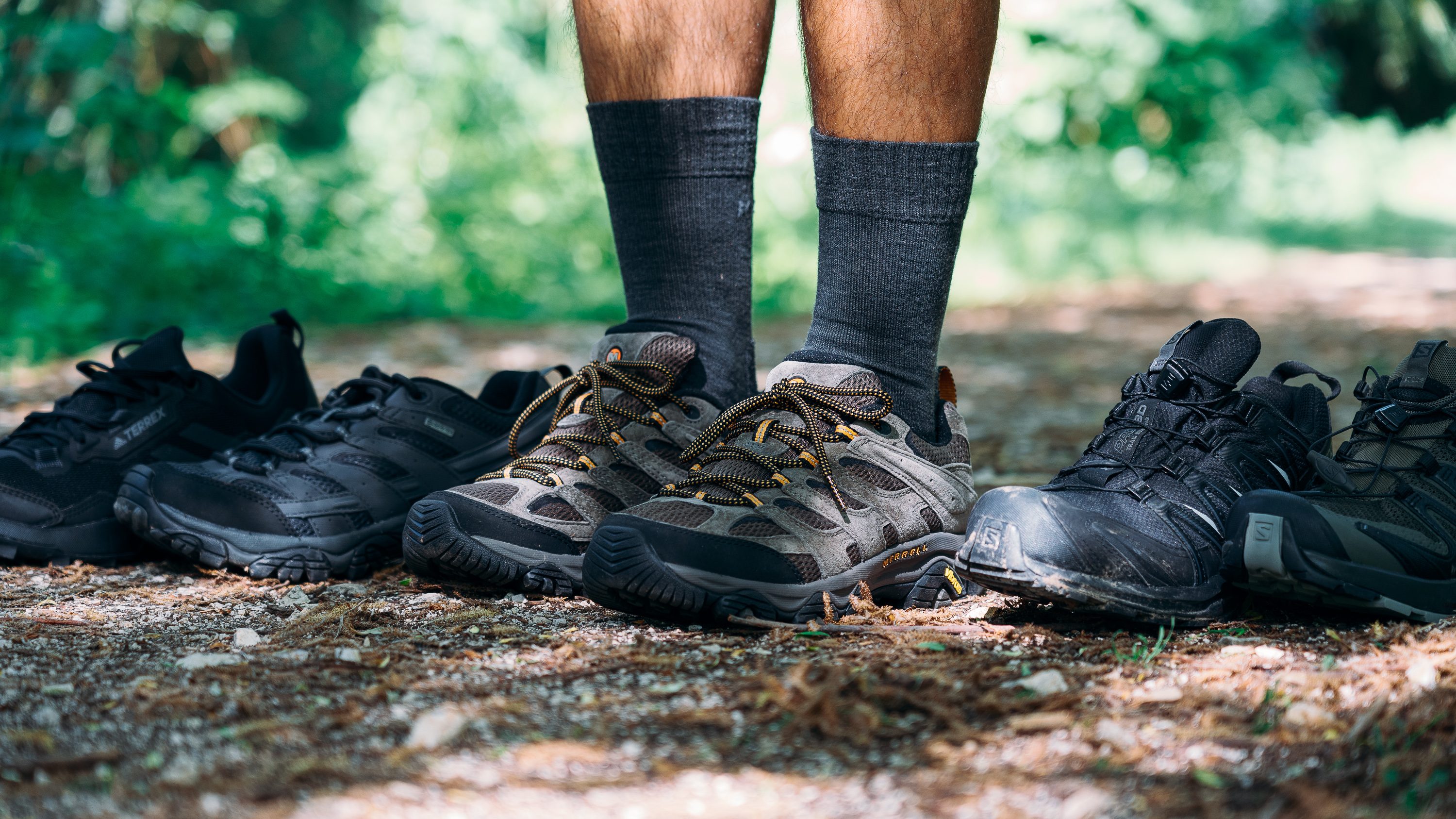
We buy shoes ourselves. We earn commissions when you buy through us, at no extra cost. Why trust us
When it comes to getting the right footgear for hiking, many are still at a loss. But don’t fret. Choosing the right pair need not be a nightmare, thanks to our best hiking shoes list and our handy buyer’s guide.
We have tested many hiking shoes to single out the best options. Whether you are after a light, urban pair or something a bit more rugged for a multi-day hike, we’ve got our top picks in different categories.
To learn about the nuances of hiking shoes, why toebox durability matters, or how stiffness affects support and stability, check out our guide.
How we test hiking shoes
At RunRepeat want to make sure you get the most up-to-date and honest reviews on the best hiking shoe options out there. Here is our approach:
- We buy shoes ourselves: As an independent review website, we avoid sponsorships and purchase all hiking shoes with our own money to stay unbiased.
- We test in real conditions: We take each shoe on a series of hikes on various distances and terrains to check every important aspect, including durability, comfort, waterproofness, traction, and more.
- We go extra hard on popular shoes: We are especially wary of the most sought-after models, so we put them through our rigorous lab tests. 'Rigorous' to the point that we also slice the shoes open!
Best hiking shoes overall
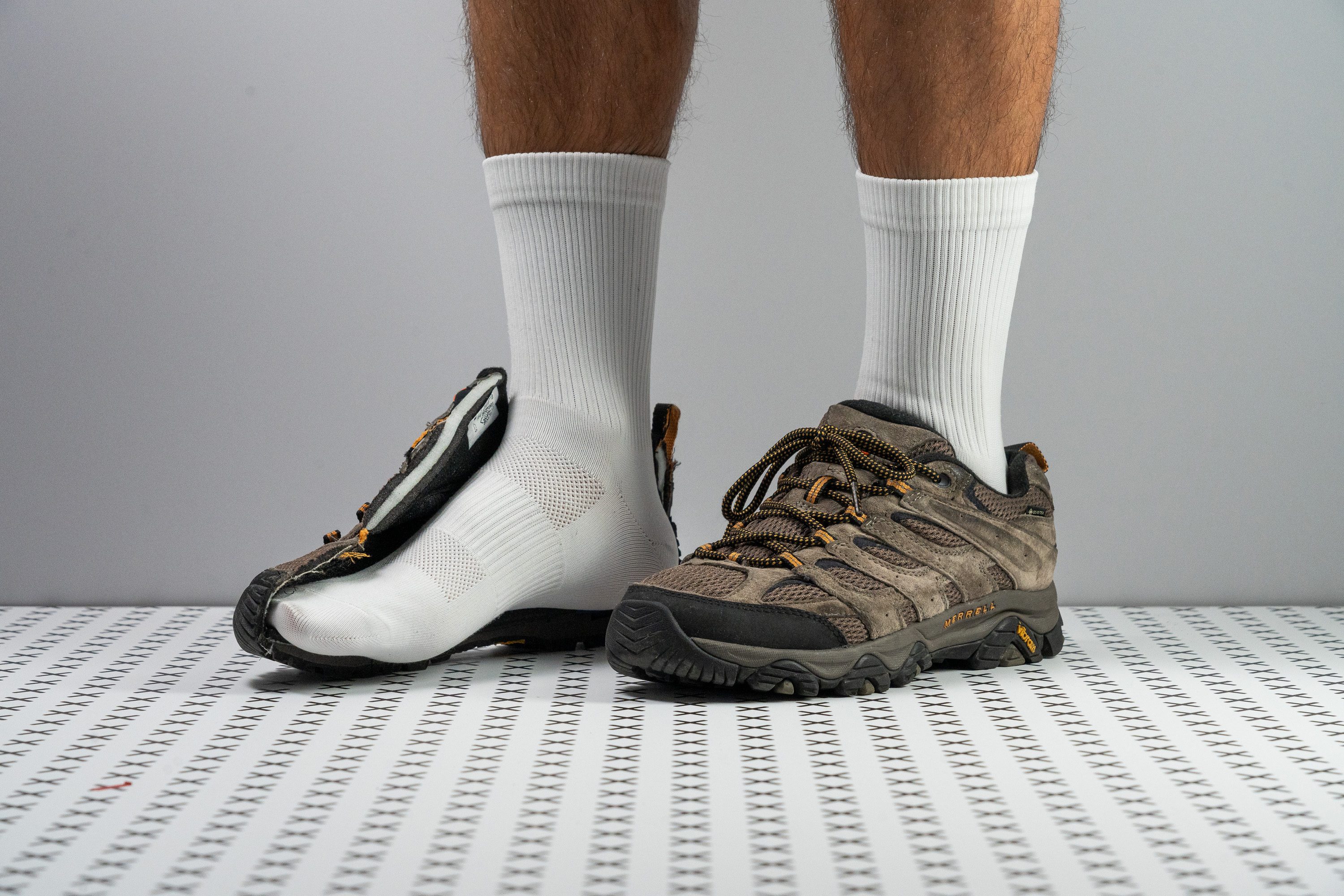


































What makes it the best?
It takes a lot to be crowned as the most comfortable hiking shoe and this shoe delivers just that: a lot. It's cushioned, padded, flexible - all wrapped up in a day-one comfort package. Its grip is out of this world and there are many details, like a gusseted tongue and very padded tongue, that seriously up the ante when it comes to overall comfort.
We've took the Moab 3 GTX to the trails and we've cut it in half in the lab. Being able to see and measure all the bits and pieces allowed us to understand why this shoe rocks at comfort. First, its cushioning. While on the firmer side, it does not feel like a brick. It feels perfectly balanced - not too firm and not too squishy. In the lab, we pressed our durometer against the midsole and recorded 35.9 HA. That's 14% more (and therefore firmer) than the average.
Second, the grip is 10/10. The outsole is 2.3 mm thick (just like the average for hiking shoes) and the lugs are 0.5 mm thicker than the average ones. Our calliper measured them to be 4.8 mm deep. Whatever we threw at them - rocks, snow, mud, gravel - they handled like pros.
The tongue is perfectly gusseted and allows nothing to get inside of the shoe on the sides of the tongue. For the rest, we have a Gore-Tex membrane to do the same job and it does it wonderfully. Our feet were dry at the end of a 20+ mile hike where rainy clouds kept following us for some reason. The best thing, though, about the tongue is its thickness. At 14.6 mm, it's 3.2 mm thicker than the average. It perfectly cushions the instep and it's the reason why we never felt any lace bites. We did tighten the laces a lot!
The Gore-Tex membrane keeps the water out. But it also keeps the air from circulating. This is why we don't recommend this shoe to hikers who regularly hike in warm climates.
Pros
- Superb day-one comfort
- Brilliant surface adhesion
- Supportive like a work shoe
- Remarkably durable
- A-grade waterproofing
- Sheds mud quite well
- Protective toe box
- Incredible overall quality
- Incredible overall quality
Cons
- Heavy for a low-top
- Subpar breathability
- Its shoelaces unravel often
- Minimal shock absorption
Hiking shoes with the best shock absorption
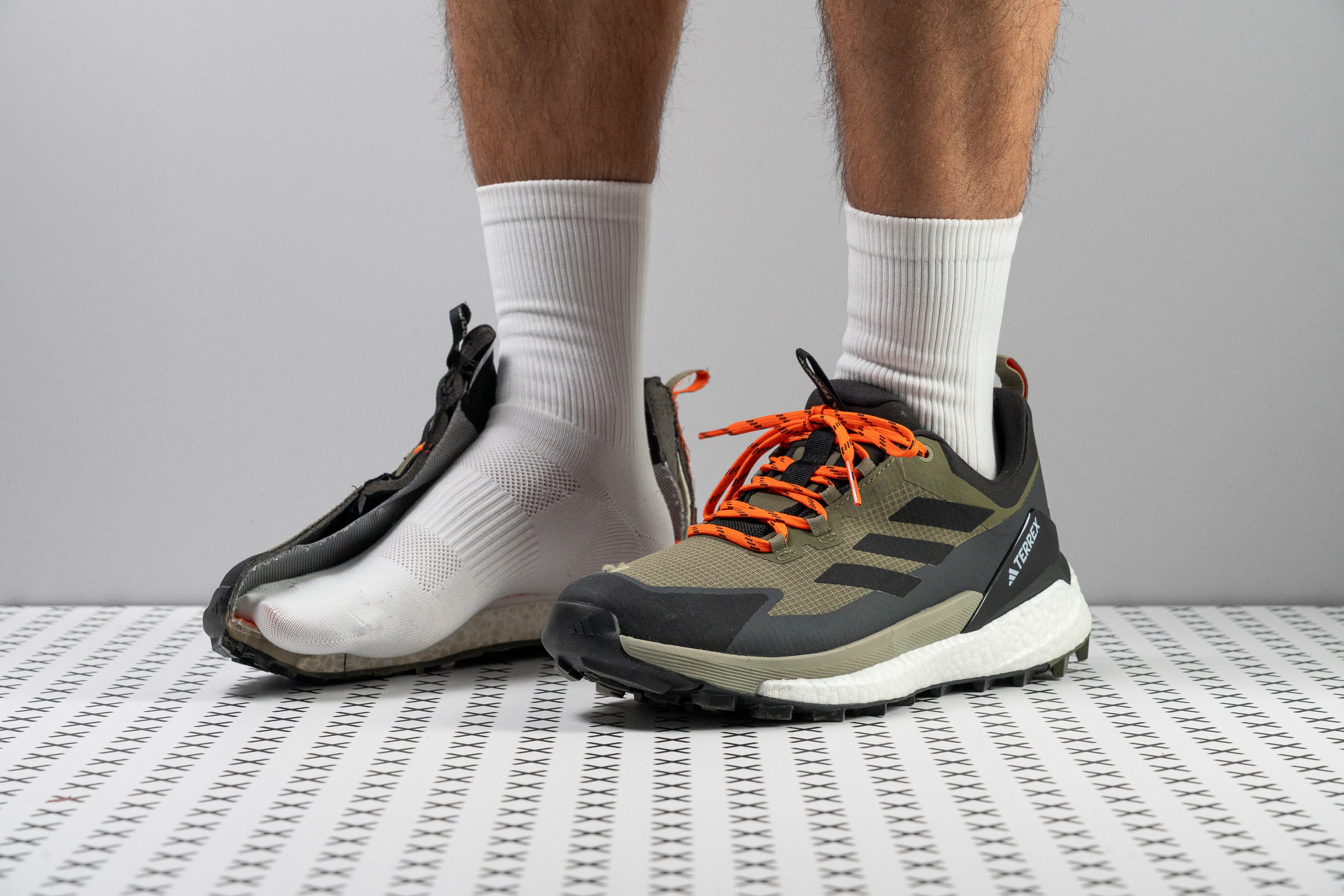



















































What makes it the best?
Our hikes felt comfortable all the way with the Adidas Terrex Free Hiker 2.0 Low GTX beneath our feet. This cushioned cruiser offers the best shock absorption among hiking shoes we analysed in the lab, coupled with a confidently steady and grippy ride to keep us safe across mixed terrains.
The TFH 2.0 Low GTX packs much foam between our feet and the ground, isolating us from sharp rocks and roots that we encounter. Our calliper shows an above-average stack height of 37.2/24.6 mm, keeping us cosy even during multi-hour adventures. Plus, it’s able to absorb 20.0% more impact than average with its 126 SA score in the heel.
We had no worries about rolling our ankles or spilling over because the shoe’s massive platform gave a well-planted feeling. Our readings show its base is 113.9/93.1 mm vs. the 111.1/87.9 mm average hiking shoe. Additionally, its high level of torsional rigidity delivers excellent lateral support, backed up by its 4/5 score in our manual twist assessment.
The outsole features the Continental Rubber compound, ensuring protection from wear. It includes a mix of badass 6.7 mm lugs in the heel and 3.6 mm lugs in other areas that grip all terrains effectively, ensuring we can fully enjoy even aggressive trails without slipping.
However, we cannot recommend this pair to people who hike in warmer climates because of its Gore-Tex upper. Those who prioritise breathability should opt for a non-GTX shoe.
Pros
- Well-cushioned and responsive
- A tonne of impact protection
- Rockered sole makes the ride smoother
- Barely gets firmer in low temperatures
- Excellent support and side-to-side stability
- Top-notch waterproofing
- Highly durable (especially the outsole)
- Ideal grip for technical terrain
- Sustainable materials (20%)
Cons
- Much heavier than average
- TPU heel clips may cause rubbing
Hiking shoes with the best stability
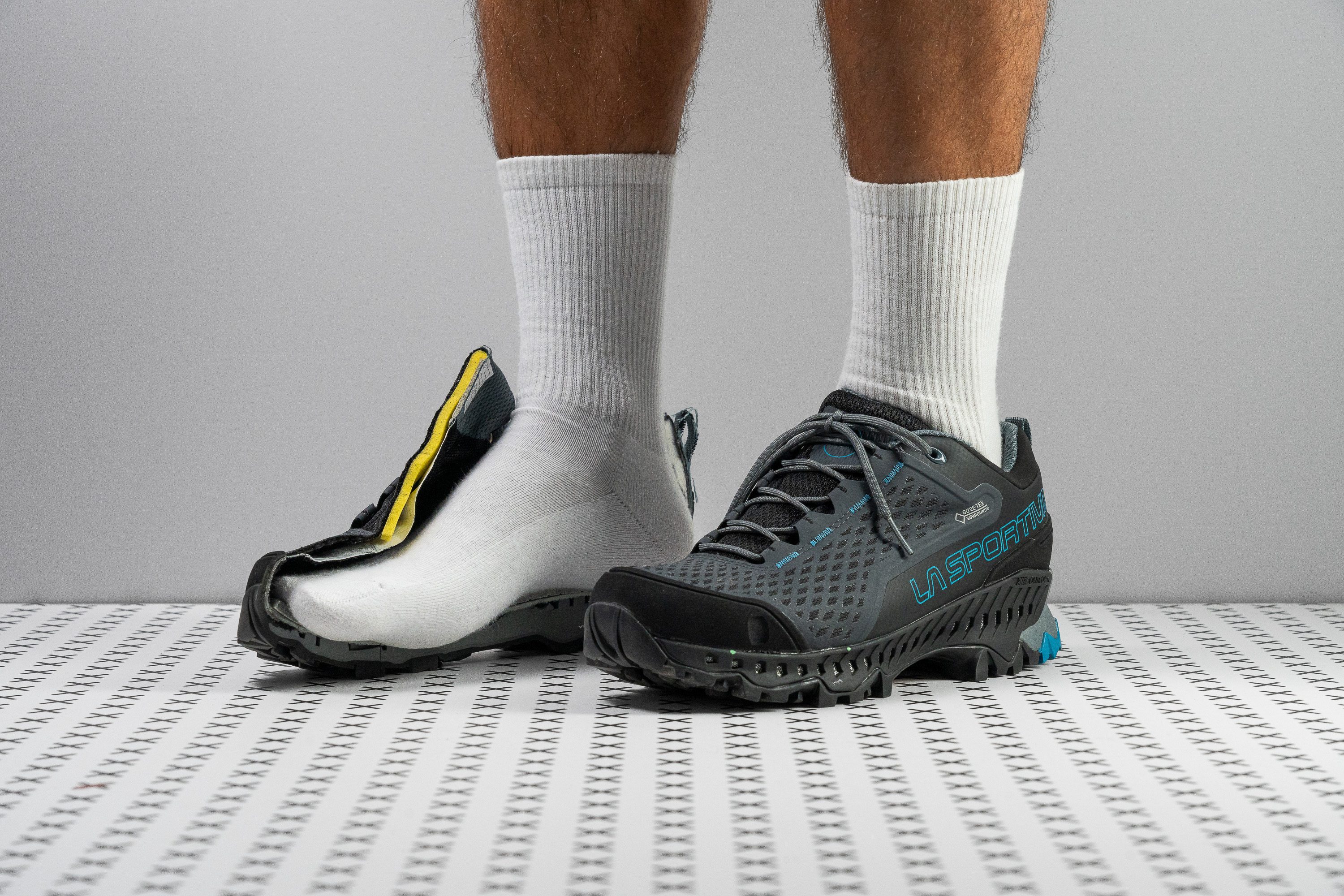





















































What makes it the best?
The La Sportiva Spire GTX displays boot-like sturdiness through its exceptional support and protection. It’s hard to miss a step in this shoe, as lab tests reveal the Vibram outsole and the STB Control System guide our strides, making it the best stability hiking shoe we’ve evaluated. Moreover, its thick cushioning became our shield underfoot.
The STB Control System is Spire GTX’s main stabilising component, featuring tall sidewalls that cradle our feet to prevent us from buckling over. It generates tonnes of torsional rigidity, which is seen in its high 4/5 score in our manual twist assessment.
Underfoot, we observed that the Vibram XS Trek outsole has deep 4.3 mm lugs that latch onto most surfaces effectively. Testing for the rubber’s traction, we recorded a high 0.36 score, confirming its grip even on wet, slippery boulders.
The midsole isolates us from the ground through its thick rear stack of 39.1 mm. Paired with a modest forefoot, the resulting 16.0 mm is steep! The benefit of this offset is that it relieves our lower legs from strain when hauling heavy loads.
However, don’t expect a cushy sensation from this shoe, since it scored below-average in our shock absorption test.
Pros
- Feels like a backpacking boot with low collar
- Unparalleled stability and support
- Superb waterproofness with some breathabilty
- Mutes out rocks and debris like no other
- Excellent grip and braking
- Sturdy and durable construction
- Greater range of sizes allows to fine tune the fit
Cons
- Can feel tippy on rocky and hilly terrain
- Frail inner lining
- Gets even firmer in cold
Best hiking shoes with a wide toebox
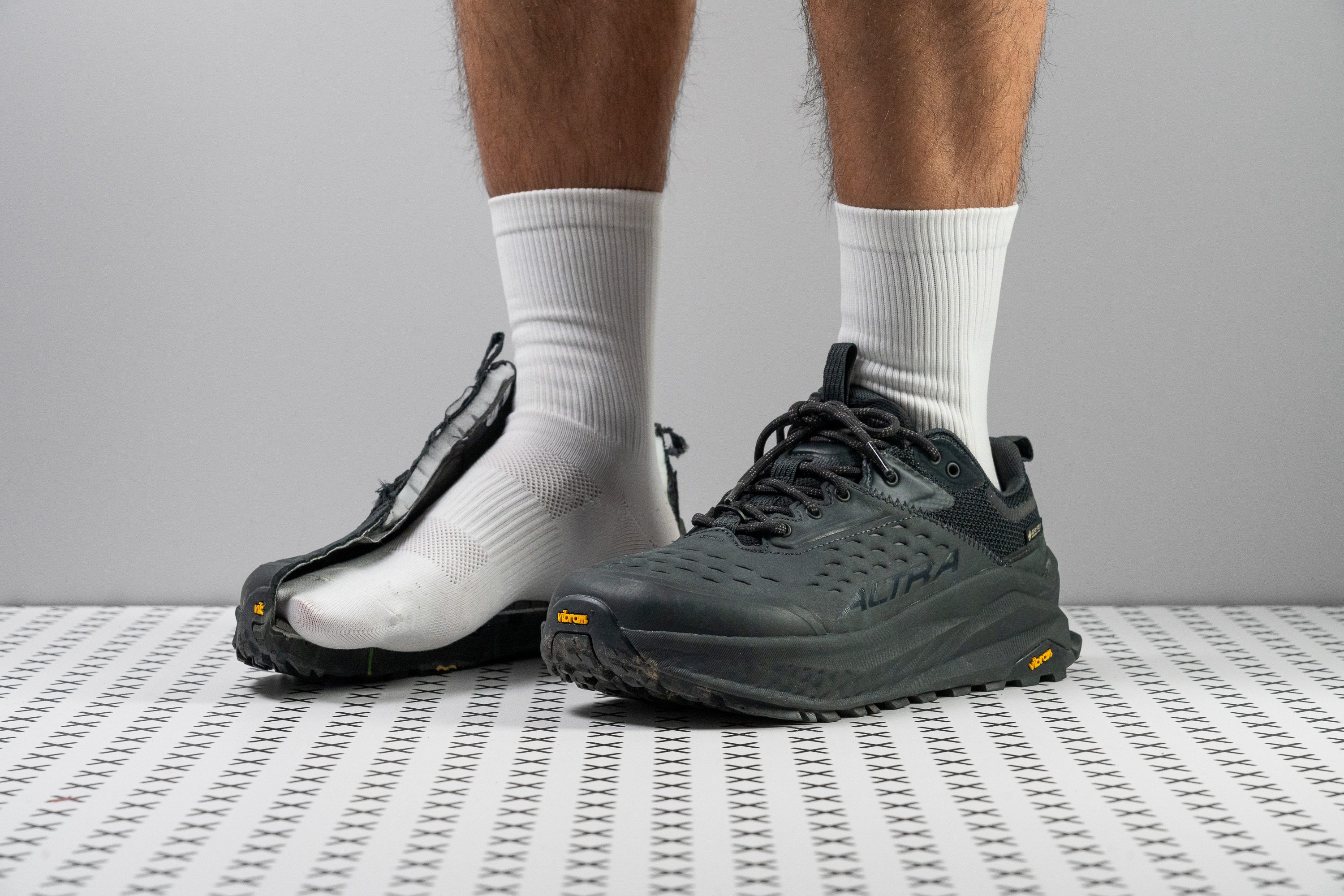
















































What makes it the best?
Altra Olympus 6 Hike Low GTX made its commitment to lasting comfort clear during our hikes. Its roomy fit and excellent impact protection make it a great place to be in for long hours, while its springy ride, which we verified in the lab, creates a more effortless experience. Among hiking shoes, it’s our top pick for those with wide feet.
This Altra promises its most spacious Original FootShape Fit, and we created a gel mould replica to confirm its interior measurements. At the ball of the foot, we recorded a record-breaking 99.9 mm, the widest we’ve seen so far! Being 5.8 mm more spacious than average, those with broad feet, bunions, or extra-thick socks won’t have to deal with pressure points.
The midsole is composed of deep cushioning, particularly its mega forefoot stack of 29.5 mm, reducing strain to our toe joints. The heel stack is a more moderate 31.0 mm, but has leg-saving properties confirmed by its high 118 SA or shock absorption score.
With this shoe’s generous dimensions, we expected it to feel bulky and slow. Thankfully, its responsive midsole makes the overall experience feel lighter, with an impressive energy return score of 55.7%.
However, its thick forefoot loses the fluidity some people crave. Flexible shoes will deliver a more natural underfoot experience.
Pros
- Excellent shock absorption
- Comfortably soft cushioning
- Ultra padded and cosy step-in feel
- Exceptionally wide fit and footshaped toebox
- Extra wide and stable platform
- Highly durable leather and outsole
- Excellent grip on smooth and wet rocks
- Solid waterproofing
Cons
- Not a true zero-drop (1.5 mm)
- Midsole gets notably firmer in cold
- Frail inner lining
Best lightweight hiking shoes
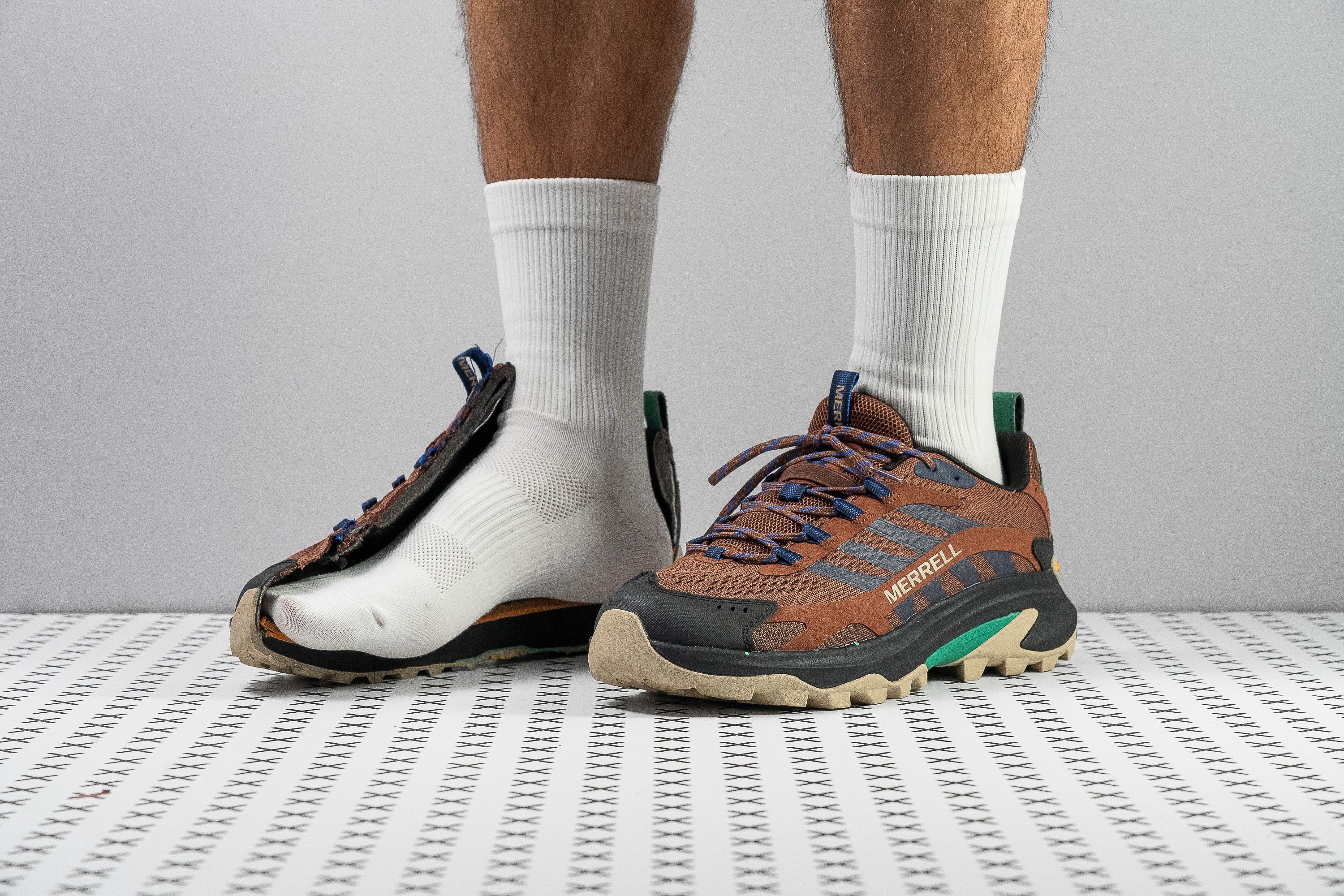























































What makes it the best?
On our test hikes with the Merrell Moab Speed 2, we already knew it was a contender for the best lightweight hiking shoe, and our lab further confirms it with a mere 11.6 oz (329g) build vs. the 13.4 oz (379g) average! Despite the 13.4% difference, this shoe blew us away with generous cushioning, solid footing, and top-tier durability.
Less weight usually means less cushioning, yet Moab Speed 2 defies the standard with a whopping 38.8 mm heel, 7.4 mm above average! All-day hikes felt effortless as the plush cushioning delivered lasting comfort. Our durometer confirms a low 19.0 HA reading, 31.4% softer than average.
While the foam is lighter than average, it is by no means unsteady because of the FlexPlate. This adds stiffness underfoot for a more controlled and stable experience, thereby preventing the early onset of fatigue. Our manual assessment confirms it’s hard to twist, earning a 5/5 torsional rigidity score.
Moab Speed 2’s all-around robust nature impressed us. Our Dremel was no match against the sturdy overlays in the upper and Vibram TC5+ outsole, earning 5/5 toebox durability and showing 20.0% less damage vs. average in the outsole.
However, we recommend limiting the use of this shoe to off-road surfaces and trails to preserve its life. The toothy 3.7 mm lugs tend to wear faster out in concrete and asphalt.
Pros
- One of the lightest hiking shoes
- Plush and abundant cushioning
- Great support and stability
- Perfect grip for moderate terrain
- Excellent durability
- Breathable for summer
- Cosy step-in feel
- Two loops for easy on-off
Cons
- Frail inner lining
- Small debris gets inside
Best city-to-trail hiking shoes
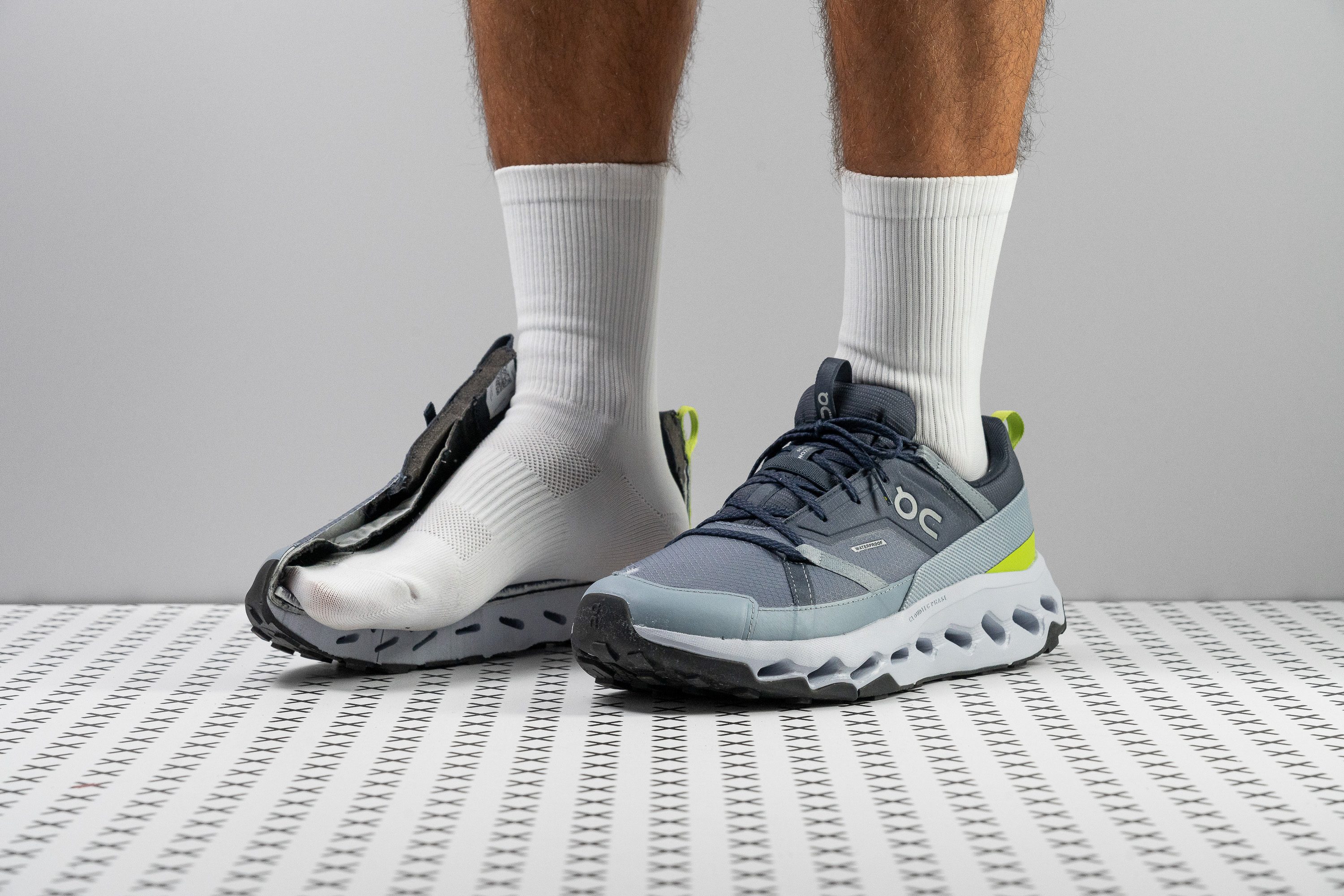





















































What makes it the best?
The On Cloudhorizon Waterproof exudes pure comfort, from its warm embrace to its highly cushioned base. Lab results show it beats the average in terms of height and impact protection, all wrapped in a minimal package, creating a smooth ride on mixed surfaces. Its fuss-free nature and comfort for daily wear make it our best city-to-trail hiking shoe.
Our lab confirms an above-average stack height of 39.4/29.2 mm. Cloudhorizon features the brand’s CloudTec technology, which compresses to reduce ground impact and springs back up for a bouncier ride. Testing for shock absorption, the heel returned a strong 126 SA rating, making it 21.2% more protective than average.
Despite its maximalism, Cloudhorizon Waterproof maintains a low 12.0 (339g) figure. Weighing 10.8% below average, it feels easy to bring around and never feels like a burden on foot.
We also had no instances of getting wet when we got caught in the rain. Its incredibly tightly-woven material didn’t allow any smoke to escape in our test, scoring the lowest 1/5 breathability rating.
With its shallow 2.3 mm lugs, it’s best to strut these shoes on urban streets and well-maintained trails. More serious hikers tackling rocky and technical terrain should go for shoes with more aggressive traction.
Pros
- Effective waterproofing
- Abundant cushioning and impact protection
- Lively and responsive ride
- Amazingly light for its stack and waterproofing
- Great as a city-to-trail shoe
- Good stability for moderate terrain
- Comfortable in-shoe feel
- True to size and fit
Cons
- Not for serious hiking
- Lacks durabiity for the price
Best budget hiking shoes
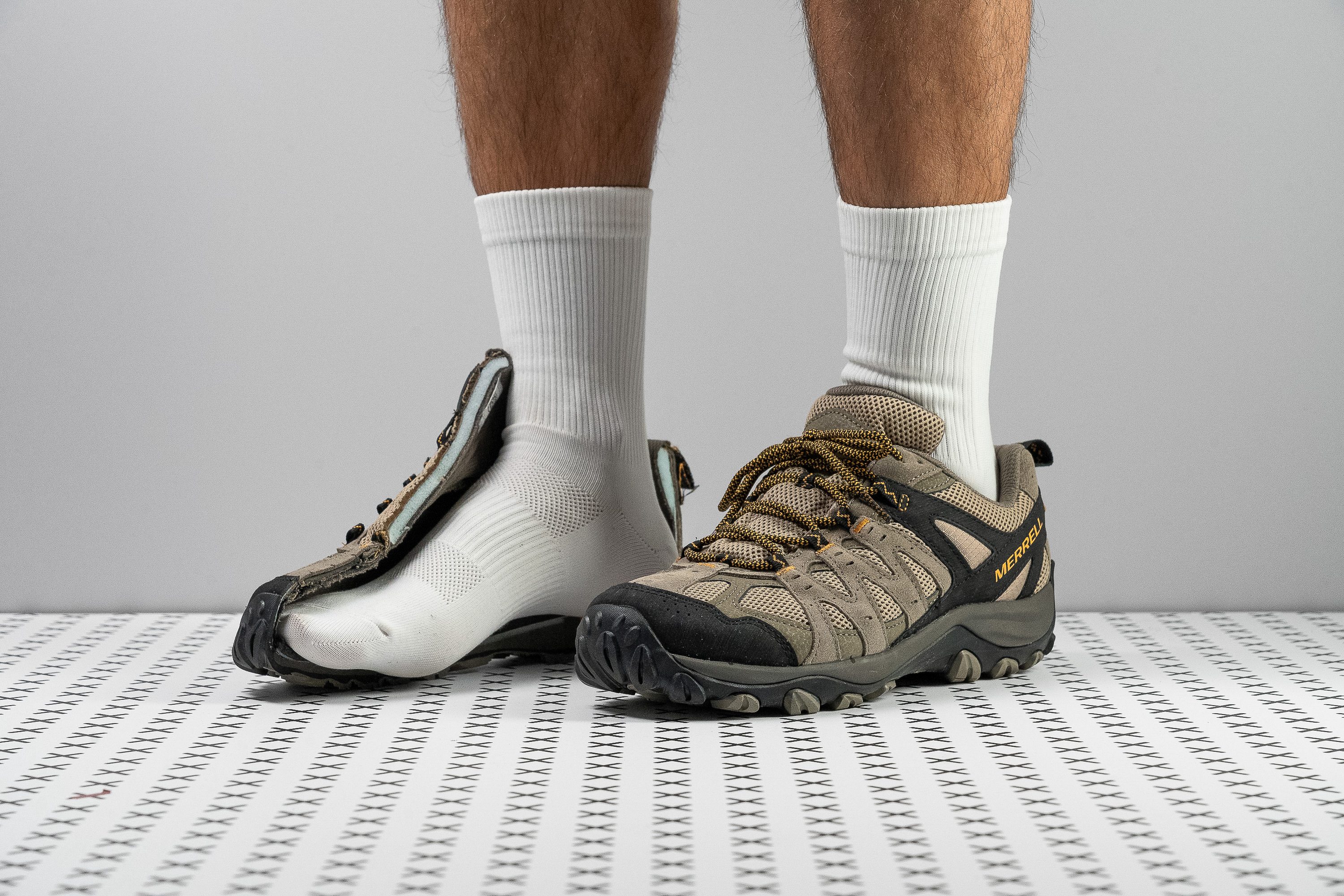












































What makes it the best?
The Merrell Accentor 3 is a no-frills companion for hiking, offering subtle support while ensuring a pleasant experience. Lab tests reveal it offers comfort through its generous room for toe splaying and its highly adaptive midsole. What’s impressive is that it only costs £100, making it 29.6% cheaper than the average hiking shoe, and topping the list as our best budget pick.
The Accentor 3 features a grounded platform, which inherently creates a well-planted ride. Additionally, we found a nylon shank under our arches, which reduces strain during long hikes. This added support makes it ideal even for those dealing with foot pain and plantar fasciitis.
With its support elements strategically positioned, Accentor 3 maintains a natural ride. In our bend test, it emerged 23.5% more flexible than average.
Besides its fluidity, the generous room in the toebox makes the Accentor 3 comfortable for long hours of wear. Using our solidified gel mould, we measured the toebox at 74.6 mm, with an extra 2.1 mm width vs. the average, so that all five of our toes can rest freely. Moreover, it has extra vertical clearance at 32.3 mm, making it suitable for those with high-volume feet.
Despite its Air Cushion in the heel, we only recorded a shock absorption score of 95 SA. For longer hikes, we recommend going for a more cushioned pair.
Pros
- Stellar support
- Amazingly comfortable
- Performs well in the cold
- Can gobble up miles
- Versatile grip for moderate terrain
- Alleviates foot pain
- Fits like a glove
- Roomy and durable toebox
- Very easy to put on
- Budget-friendly
- Sustainably made
Cons
- Lacklustre breathability
- Could be lighter
- Unruly laces
Do you actually need hiking shoes?
Generally, common hiking shoes offer more protection, traction, and stability than trail runners and trainers. We have wear-tested and lab-tested all of these and can confidently guide you towards the right choice.
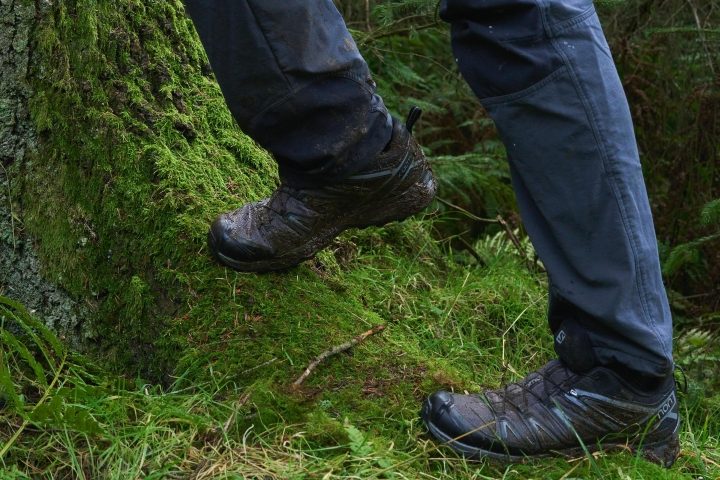
When you might get away with your running shoes:
- You’re the athletic type and know your way around spending time outdoors.
- You plan to do easy hikes: short, on rather even terrain, with no technical sections (sharp rocks, debris). Hard-packed and well-maintained trails can be covered in running shoes.
If, however, you plan to get into hiking for real and do frequent hikes, longer hikes, especially the ones with heavy backpacks and demanding terrain, then a sturdy, supportive, and grippy pair of hikers is what you need.
We’ve inspected hiking footwear inside out - in the lab and out on the trails. What matters in hiking is:
- Type of the terrain (hard ground or soft ground; hard-packed or loose)
- Season (do you need waterproof features? Is there any slush, mud, snow?)
- Weight of your backpack (backpacking asks for more stability and support)
- Length of the hike (easy and short hikes can be done in shoes meant for hiking fast and light, while longer hikes, especially multi-day ones, ask for support and stability).
We’ve combined these into the most frequent combinations. Here’s how we’d go about finding the right pair.
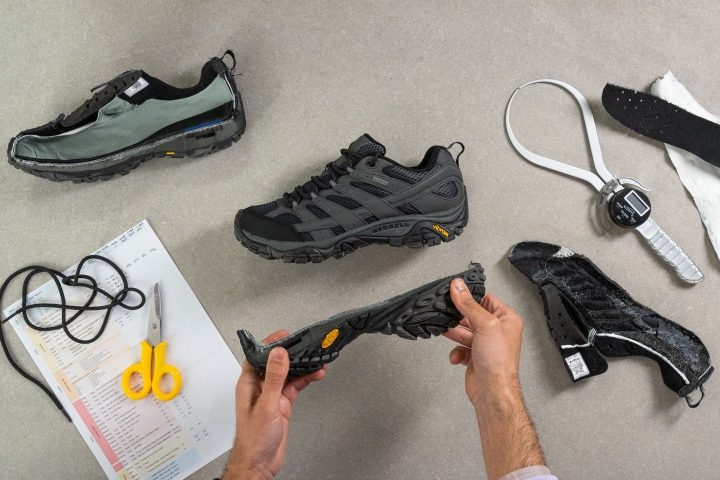
When to get an all-around day hiking shoe
You plan to do hikes that are rather easy and short. No technical terrain, scrambling, no heavy rain and snow.
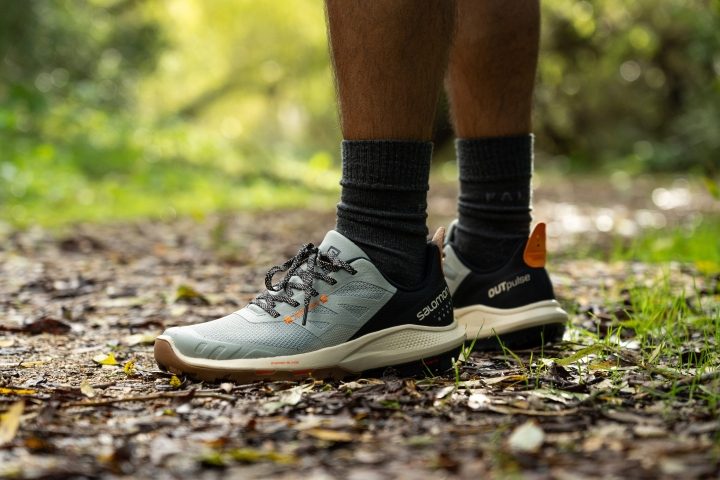
We suggest getting a workhorse of a hiking shoe that will work in most cases but won’t excel at one thing specifically.
Features to look for:
- Lighter weight, around 14.1 oz (400g) or less
- Average-to-high breathability, which means shoes that scored 3, 4, or 5/5 on our breathability lab test*
- Average-to-high flexibility because they allow for more natural foot movement. Stiffer shoes are better for technical terrain when you need extra stability. We measure the flexibility of every shoe and compare it to the average in the review.
- Average lug depth (4 mm). We say average because the smallest lugs might not have enough grip and are best used in hybrid situations (covering both road and trails) and because very deep lugs will wear out soon and are best used on soft ground only.
*In case you do plan to hike in wet weather, check out our list of waterproof hiking shoes we’ve tested so far. We dive into details on waterproofing further down.
Keep in mind that, by default, these shoes are less breathable. The waterproof membrane does not breathe well.
Fast and light hikes ask for the lightest shoes
You want to cover as much ground as possible in little time. You want to move fast and light. Some brands even have an apparel category called FL (fast and light).
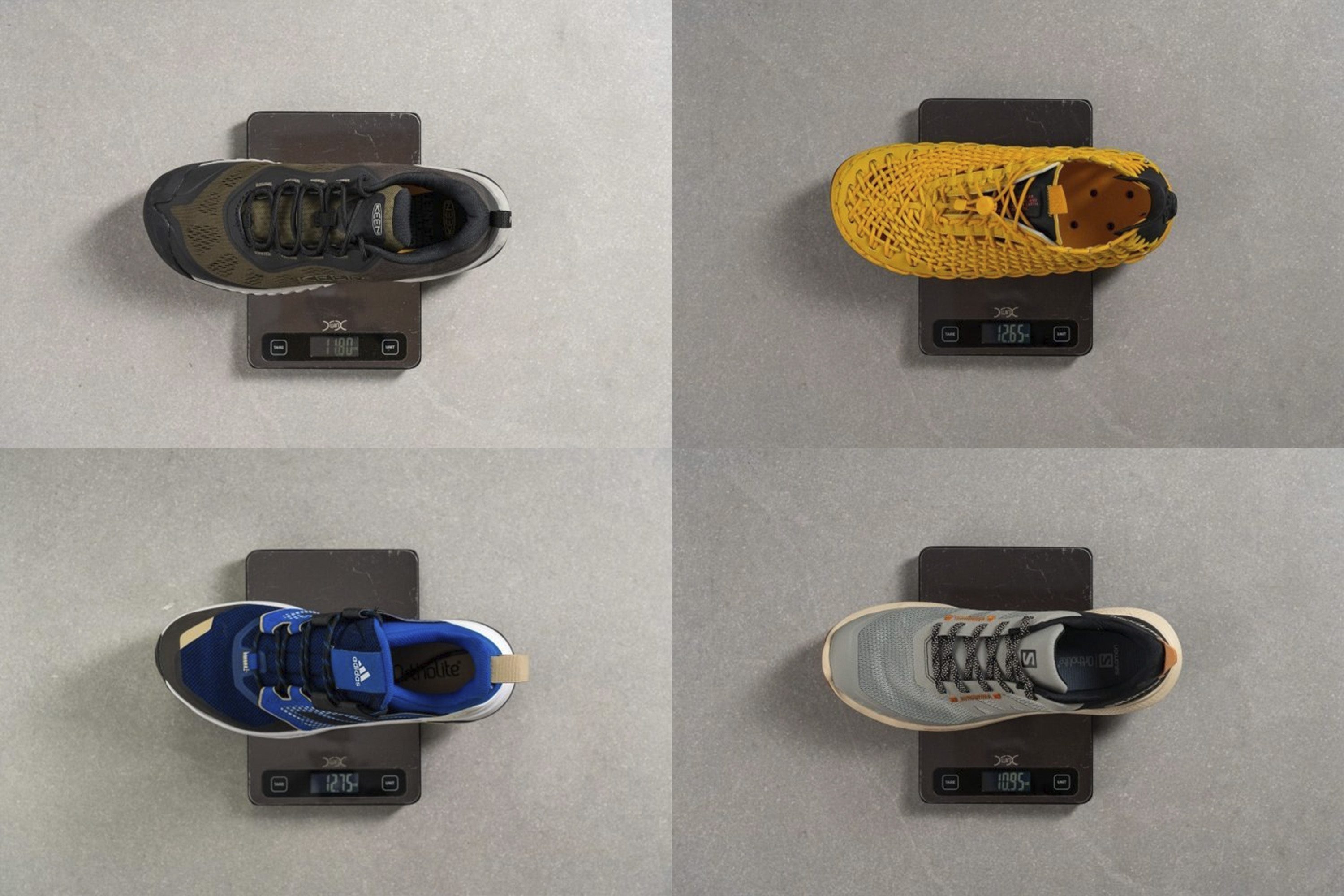
In this case, we suggest getting the lightest hiking shoes out there:
These shoes are usually not especially stable because hikers sacrifice stability elements for lighter weight.
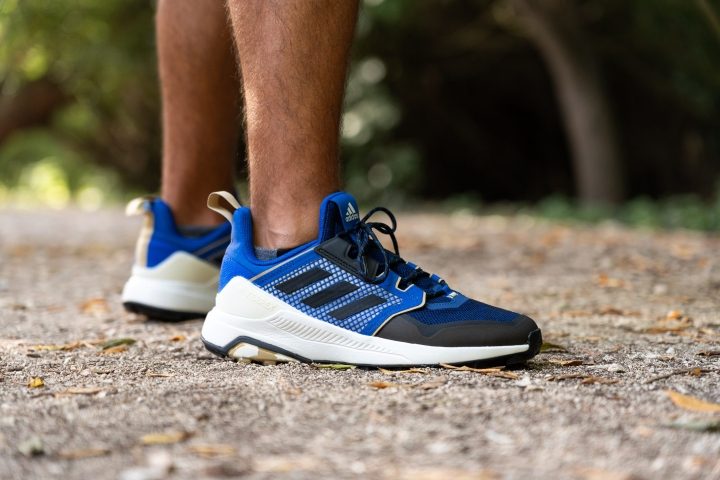
Hiking shoes for mud: deep, deeper, mud
Hiking on technical terrain, dealing with obstacles and debris on the trails, covering large muddy areas or even scrambling - you can’t do it all in the same shoe. At least not well.
Based on our wear tests, the deeper the lugs are, the better the hiking shoes perform in mud. What also plays a role here is the distance between the lugs. Too cramped and they collect the mud. Distanced from each other and we can’t believe how good the shoe is at shedding the mud.
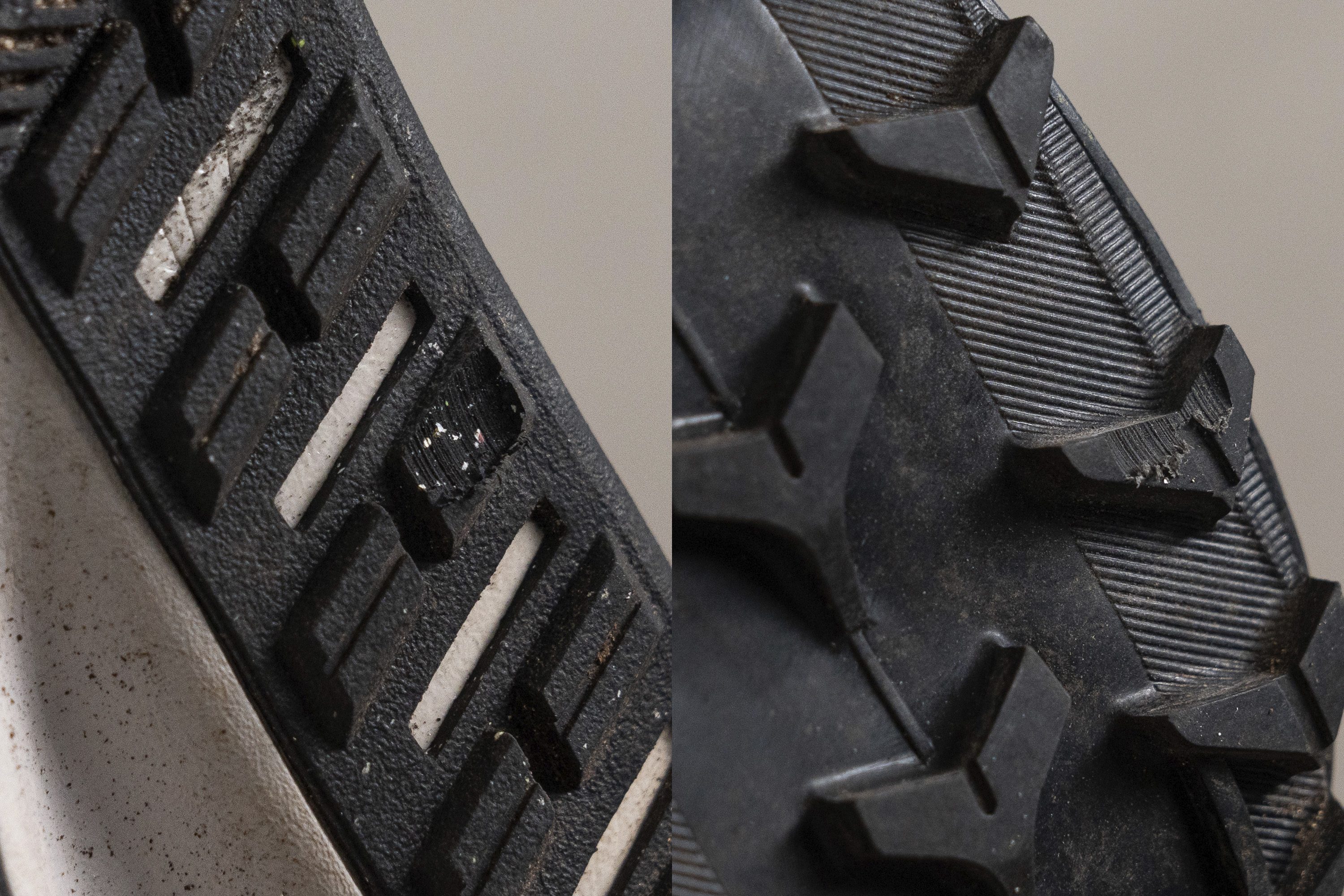
Our general guideline is: use hiking shoes with deep lugs (4 mm and deeper) for soft wet terrain like mud, slush, snow. Use around-the-average lugs (4 mm) with sticky rubber for more flat surfaces (like rock).

Not all rubber is the same and the sticker it is, the better. Keep in mind though: softer rubber wears down faster, especially when you use mud shoes on hard surfaces (like asphalt, concrete, rocks).
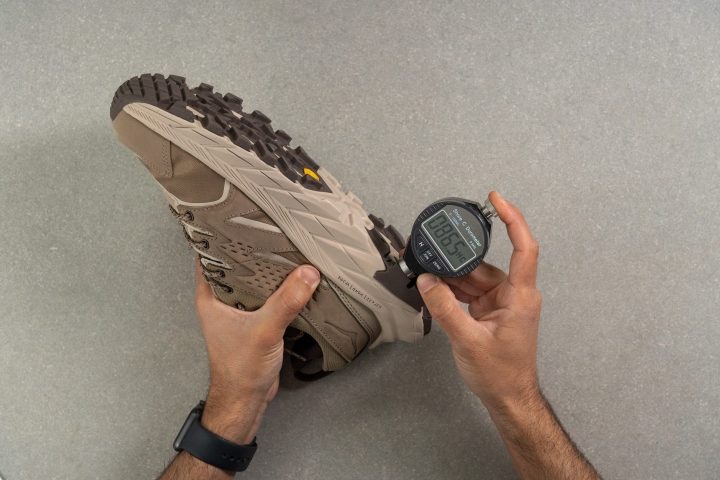
We use an HC shore durometer in our lab to measure the hardness of the rubber. Lower the number on a 1-100 scale, softer the rubber.
Hiking shoes for technical terrain: prioritising durability and stiffness
When hiking over rocky terrain, we advise going for firmer and stiffer shoes. Soft and flexible hiking shoes are great for nimbleness and softer (less dangerous) ground. Sharp rocks, especially a lot of them, ask for a firmer midsole - so that you don’t feel every little bump underneath your feet. And they ask for stiffness because stiff shoes feel more stable and safe (than flexible shoes) on such terrain.
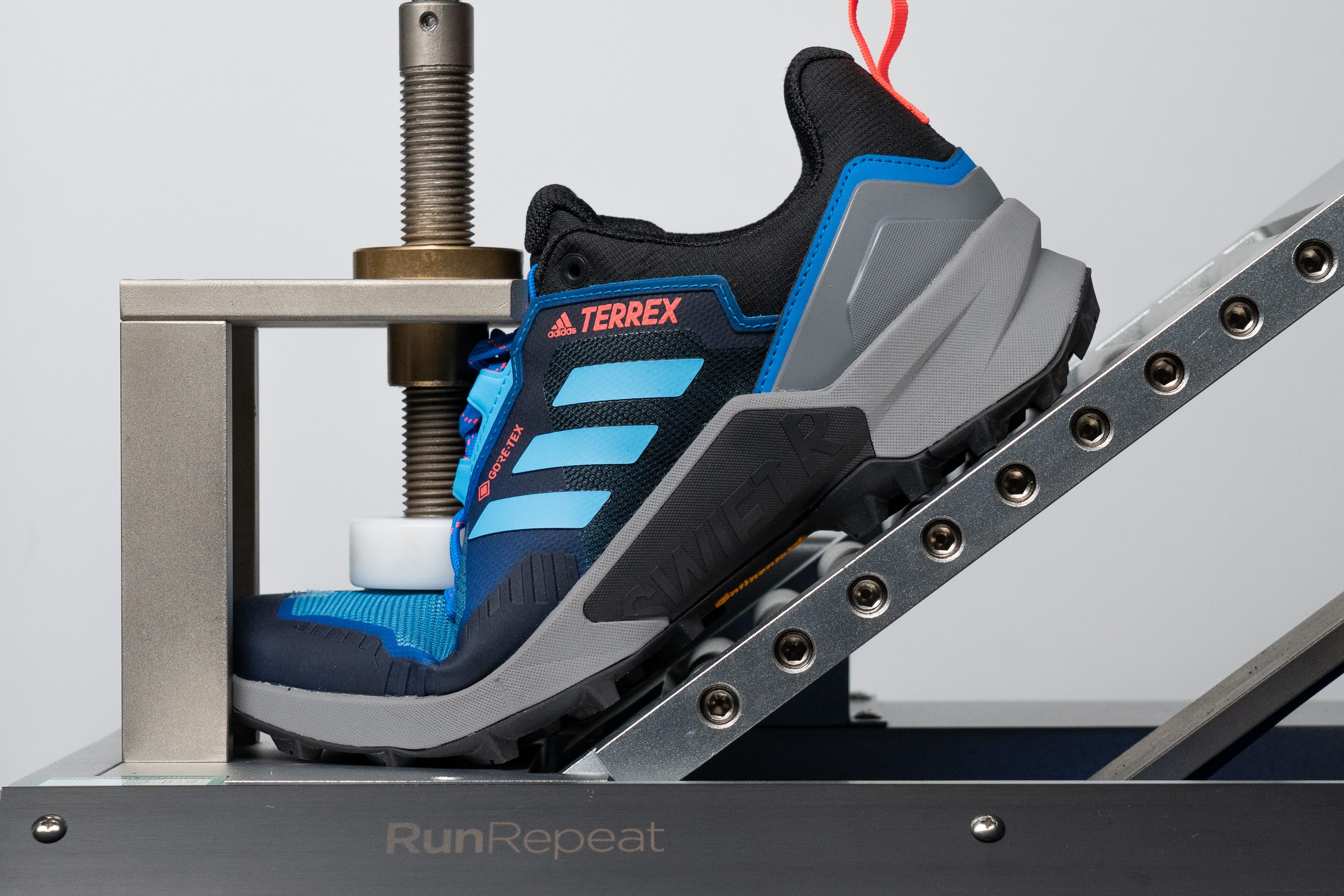
We use a machine to bend the shoe to 30 degrees and the more force is needed to do that, the stiffer the hiking shoe.
Our measurements of the midsole softness are as objective as possible: we cut all the shoes in half and poke them with a durometer.
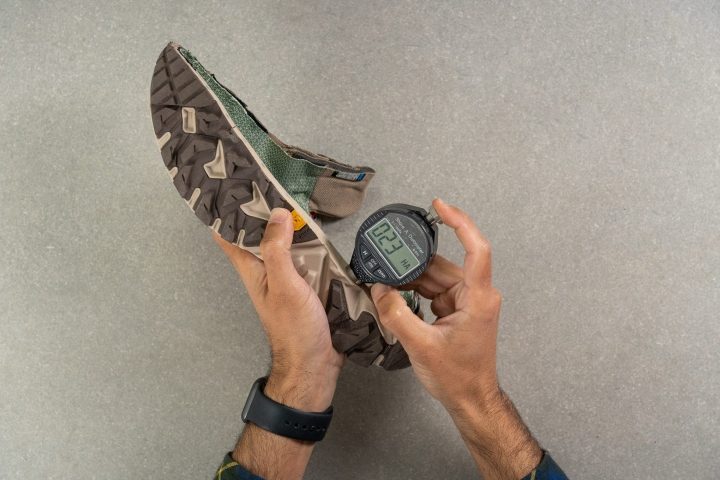
The HA durometer tells us how soft the midsole is. The higher the rating, the firmer the midsole.
If you’re planning to do a hike with a lot of obstacles, fallen trees and branches, and similar objects that can’t wait to poke your toes and destroy the shoes, we recommend looking for the most durable hiking shoes.
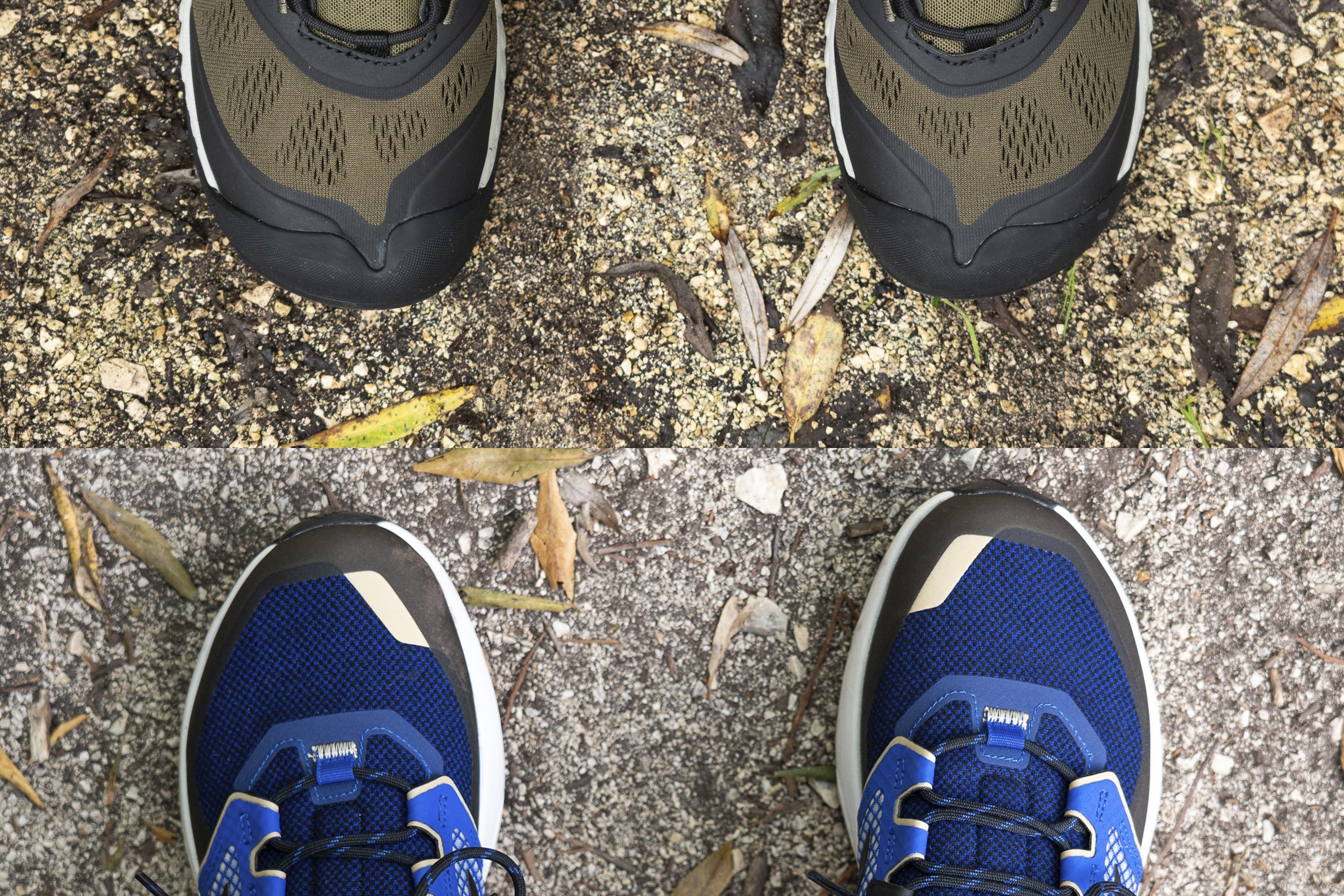
In the lab, we measure the durability of the upper and the outsole. We press the Dremel against both surfaces and examine how much damage there is. When it comes to the upper durability, we assign a rating of 1-5, where 1 is the least durable.
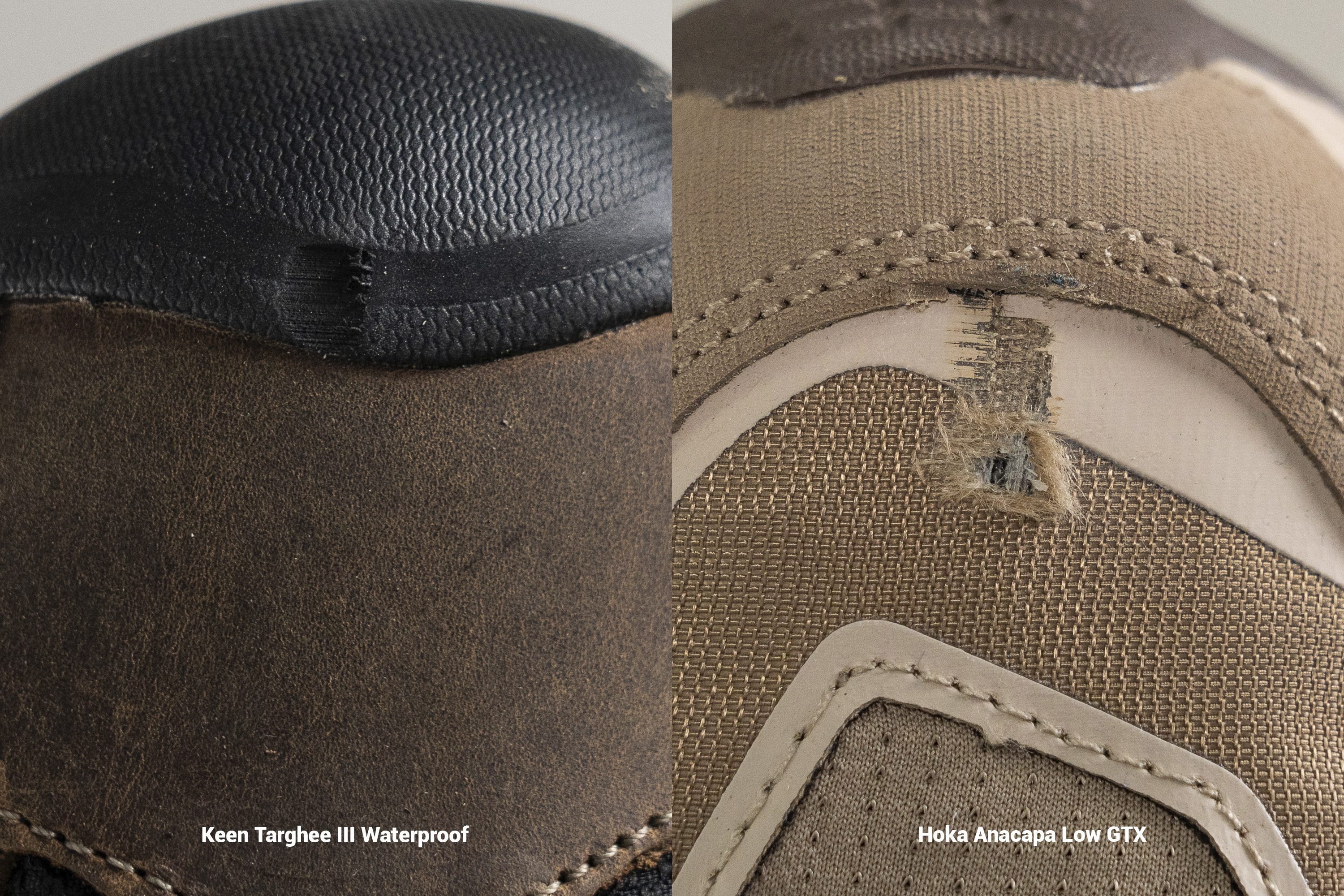
In the case of the outsole, we use a tyre tread depth gauge and check out the depth of the dent (in millimetres) our Dremel has made.
Fewer millimetres in the dent means more durability!
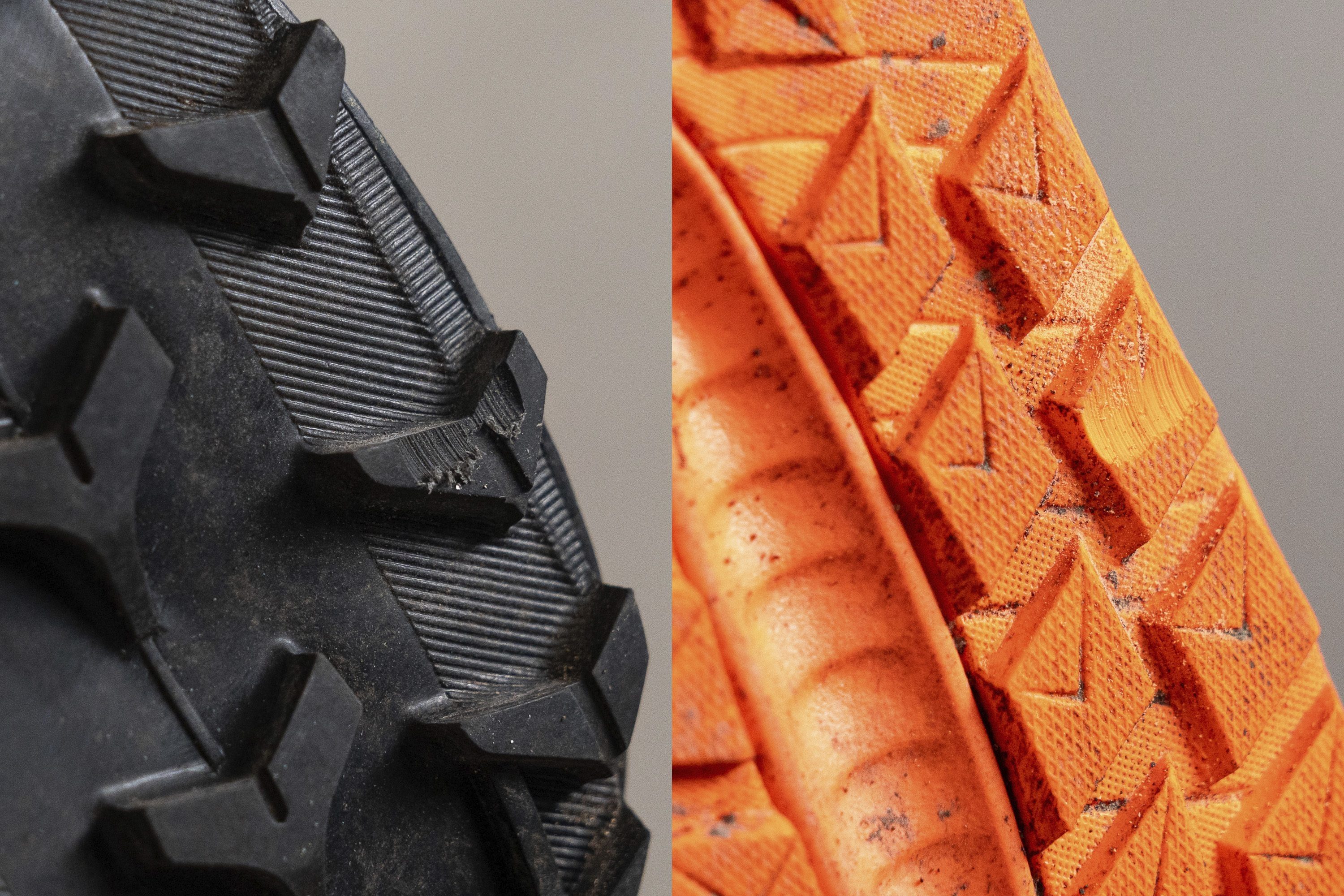
Based on all those tests, here are hiking shoes that score the highest in the durability department:
Carrying a heavy backpack: look for support in hiking shoes
If you’re packing light and bringing just the essentials, lightweight hikers will do. However, if you’re backpacking or simply need to carry a heavy load, we suggest you look for hiking shoes that
- offer lateral support (supportive features on the upper are present and give it more structure)
- are at least averagely cushioned (basically, skip minimalist hiking shoes)
- are on the firmer and stiffer end.
Cushioning, firmness and stiffness are always laid out in our reviews, along with the comparison to the average. On our wear tests, we assess the lateral stability of the shoe:
Support elements on the upper literally feel like they are locking the foot in place.
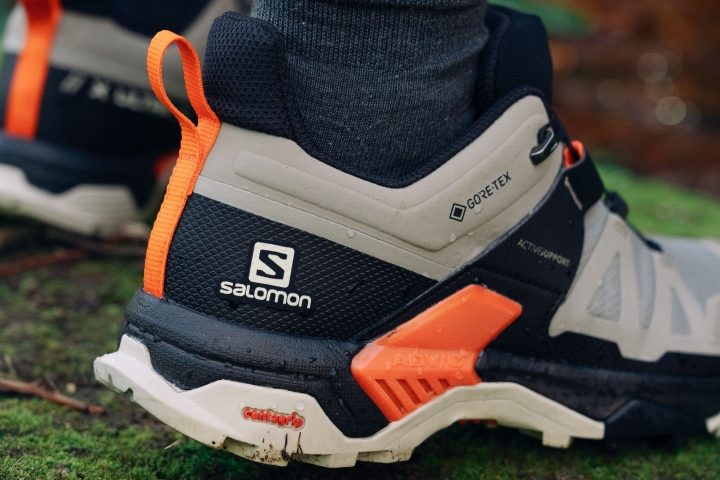
When it comes to cushioning, minimalist or barefoot hiking shoes are shoes we don't recommend. They don't have enough material between your feet and the ground and, therefore, not enough impact protection, any other protection, support or stability. See how flexible, wobbly and low-to-the-ground this minimalist V-trek hiking shoe is:
As discussed above in the technical-terrain section, hiking shoes that are too soft and flexible and almost running-shoe-like will make it difficult to walk with a heavy load.
Another thing we check in this department is the stiffness of the heel counter. Stiffer heel counters offer a better heel lockdown and, therefore, such shoes feel more stable. We rank it on a 1-5 scale, where 5 is the stiffest.
Shock absorption in hiking shoes
When talking about hiking, we often think of protection. But, we can look at 2 types protection. One would be protection from the surroundings, like sharp obstacles, sharp rocks, tree branches, and so on. For this, we look for thick toe bumpers, strong upper materials like leather, thick and hard outsoles, and so on.
On the other hand, we have protection from the impact forces or from the stress that our legs would have to deal with. Often, they get less on their plate thanks to the midsoles with good shock absorption. Good shock absorption means that the midsole is good at dampening the impact, so that the hikers' legs don't have to handle the impact forces on their own. That would be felt in muscles, joints, and overall legs, and would inevitably lead to premature leg fatigue and maybe even foot pain.
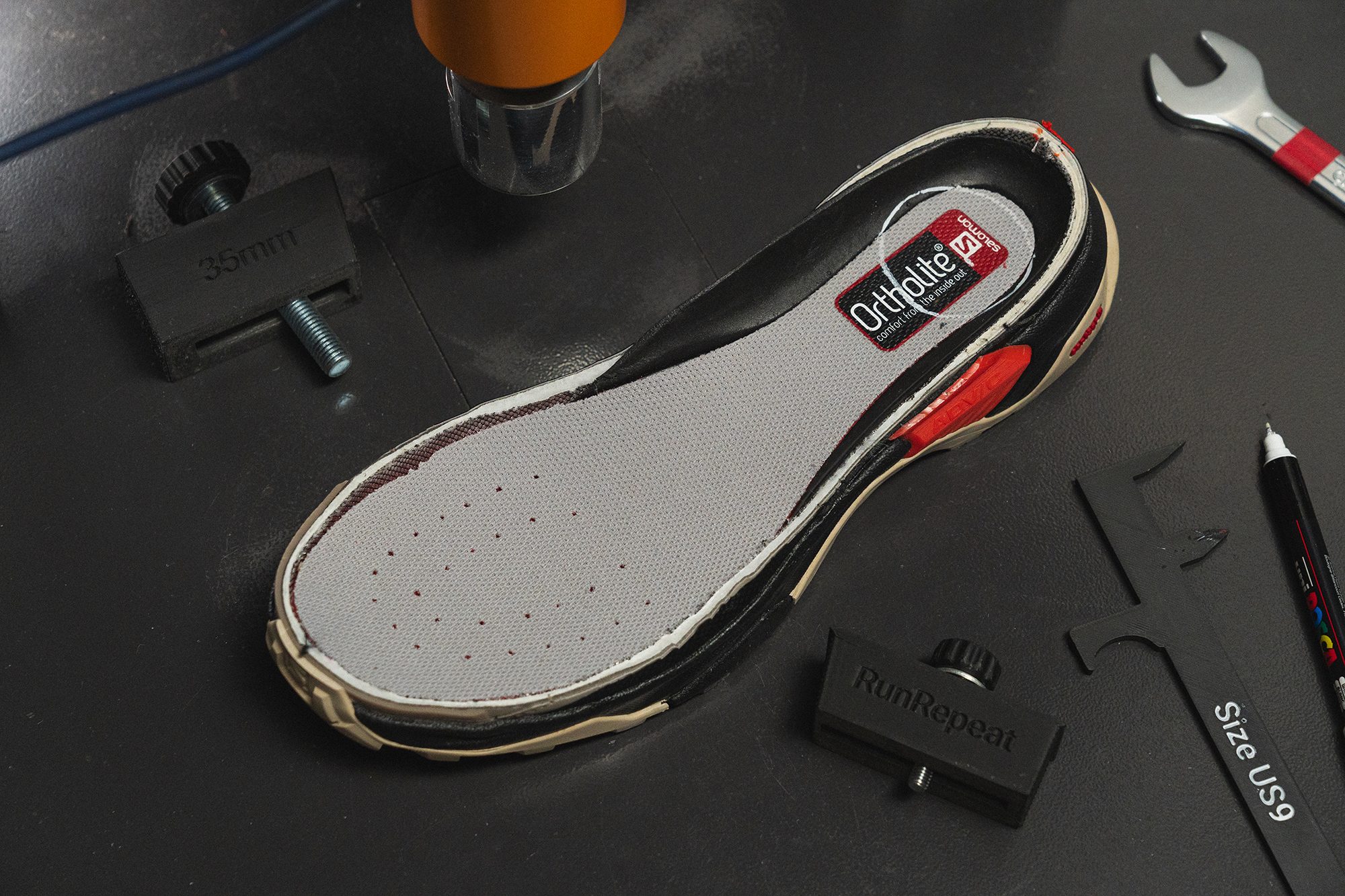
In hiking shoes, we have 3 groups of shock absorption: low (less than 100 SA), medium (100-115 SA), and high (above 115 SA).
Most breathable hiking shoes: best for summer
When testing breathability, we don’t just wear the shoes in hot weather but also examine them in the lab. We pump the smoke into the shoes to see how much smoke will come out and where and, based on it, give the breathability rating 1-5, where 5 is the most breathable.
We also perform 2 more assessments: we check the upper above the flashlight and look at it under the microscope.
All these tests combined allow us to present the most breathable hiking shoes:
Hiking in rain and snow: look for waterproof hiking shoes
In order to keep your feet dry when hiking in wet weather, we recommend getting waterproof hiking shoes. The waterproof membrane most often used here is Gore-Tex or GTX. Snow hiking shoes are also waterproof but have deeper-than-avera lugs.
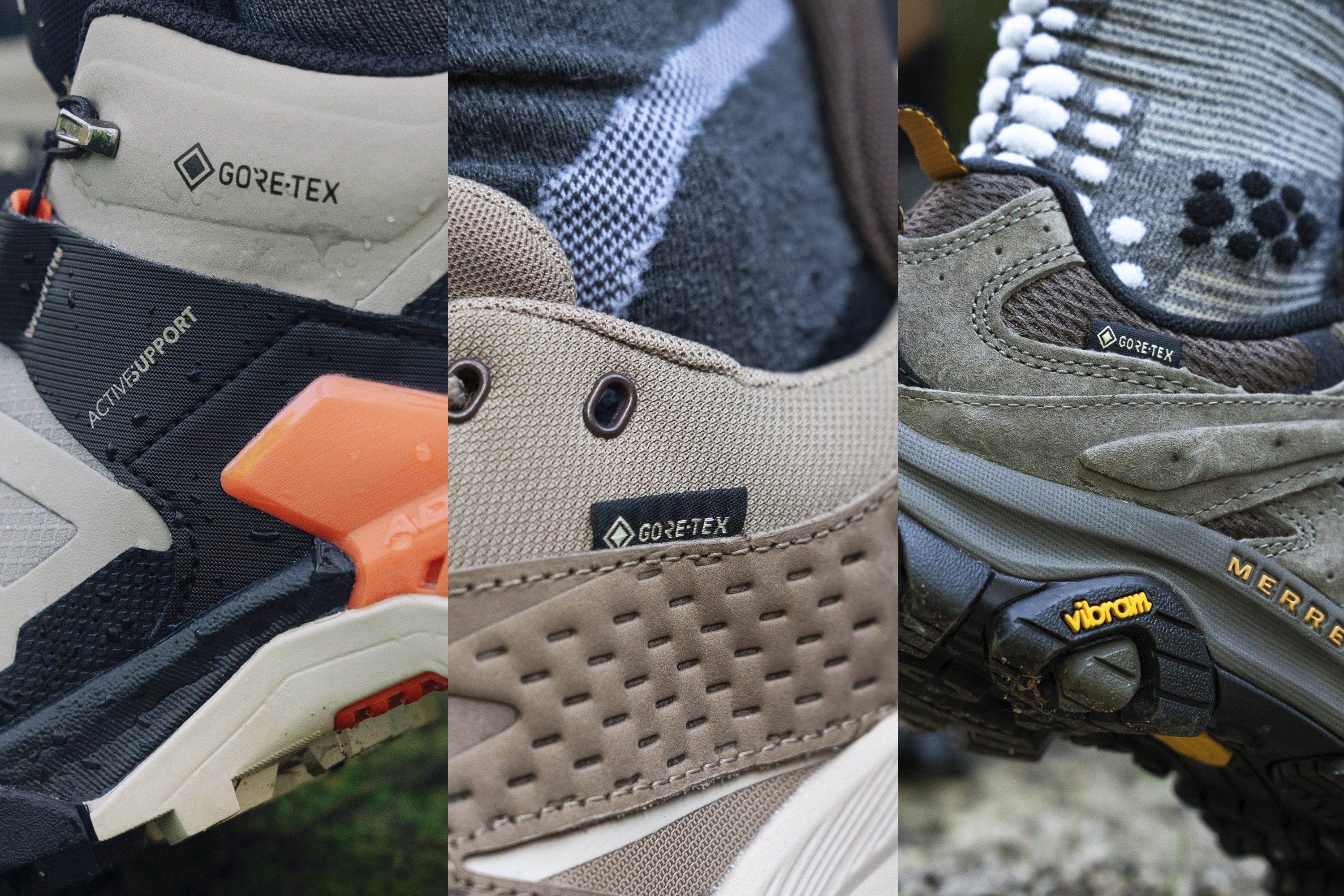
Waterproof hiking shoes usually have “Waterproof” or “GTX” in their name.
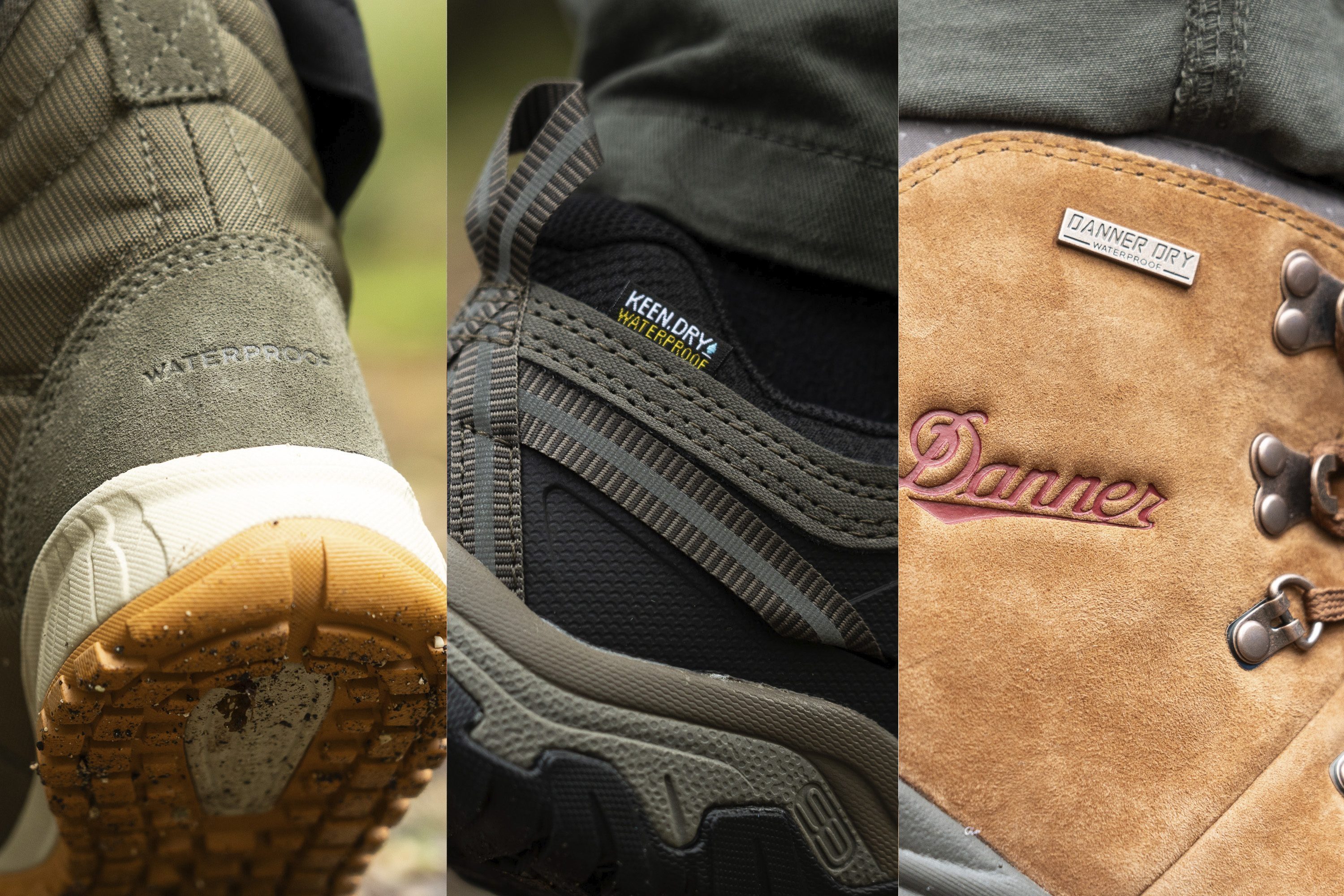
There 3 things to keep in mind when buying waterproof hiking shoes:
- They are not breathable. The membrane breathes a bit but usually it is average at its best.
- Water can still get inside your shoes by sliding down your legs or trousers or covering deep water levels.
- Once the water gets in, it is almost impossible to get it out due to the lack of breathability. Don’t expect the shoe to dry on its own together with your socks as you keep going. This could happen in non-Goretex trail running shoes that are very breathable, but not in waterproof hiking shoes.
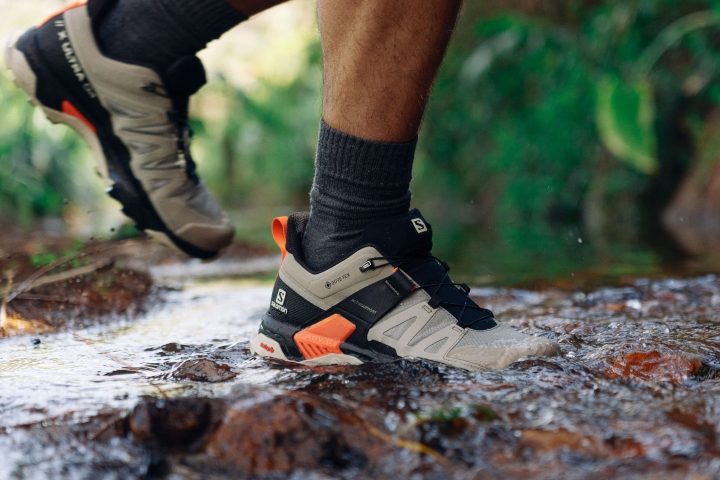
Learning the basics: Waterproof, water-resistant, and water-repellent materials
Labels like waterproof, water-repellent, and water-resistant often cause confusion. This overview offers clear guidance:
| Water-resistant | Water-repellent | Waterproof | |
| General characteristics | a tightly woven fabric that is naturally capable of resisting water upon contact | fabric treated with durable water-repellent (DWR) or hydrophobic chemicals | -fabric treated with DWR -have waterproofing membranes like Gore-Tex and OutDry -have seam-sealed construction for extra protection |
| Water protection level | low water protection | moderate water protection | high water protection |
| Water pressure resistance | 0-5000 mm (no pressure or moisture) | 6000-10000 mm (light pressure) | 10000-20000 mm (high to very high pressure) |
| Weather conditions best used in | light rain shower and dry snow | light rain and average snow | moderate to heavy rain and average to wet snow |
Hiking cold weather: hiking shoes best for winter
Not that these shoes should be waterproof but they should also behave well in cold weather.

We test this by measuring the flexibility and midsole softness at room temperature and after the shoe has spent 20 minutes in the freezer. We don’t want a shoe to feel like a brick at sub-zero temperatures!
Here are winter hiking shoes with the smallest difference in the 2 measurements:
Wide toebox in hiking shoes: measured in the lab
When looking for hiking shoes that fit wider forefeet, it’s easy to get lost in the reviews people leave because we all have different feet.
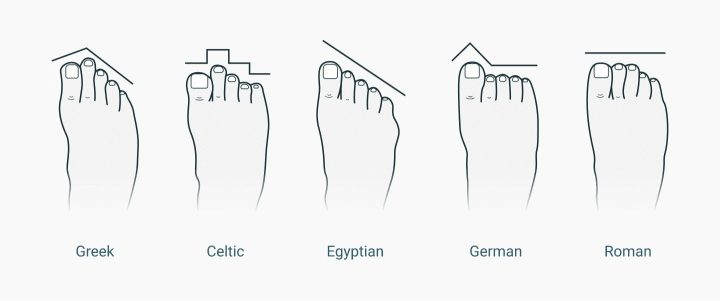
Because of that, our lab measurements are as objective as they get: we always use the same calliper to measure the width of the shoe and we do so 2 in places: where the shoe is the widest and where the big toe is. And, we do it on the gel mould that perfectly fills the interior of the shoe!
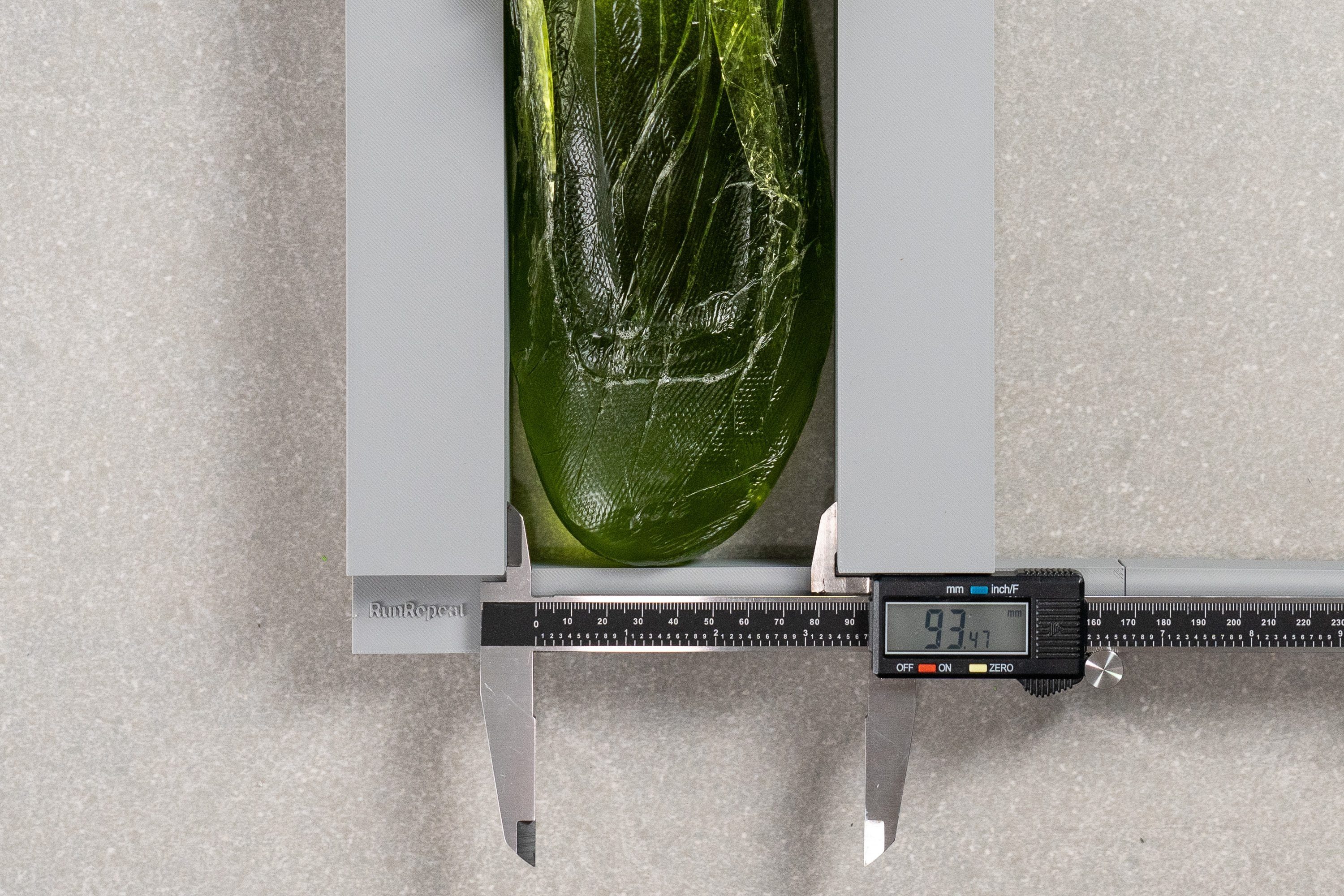
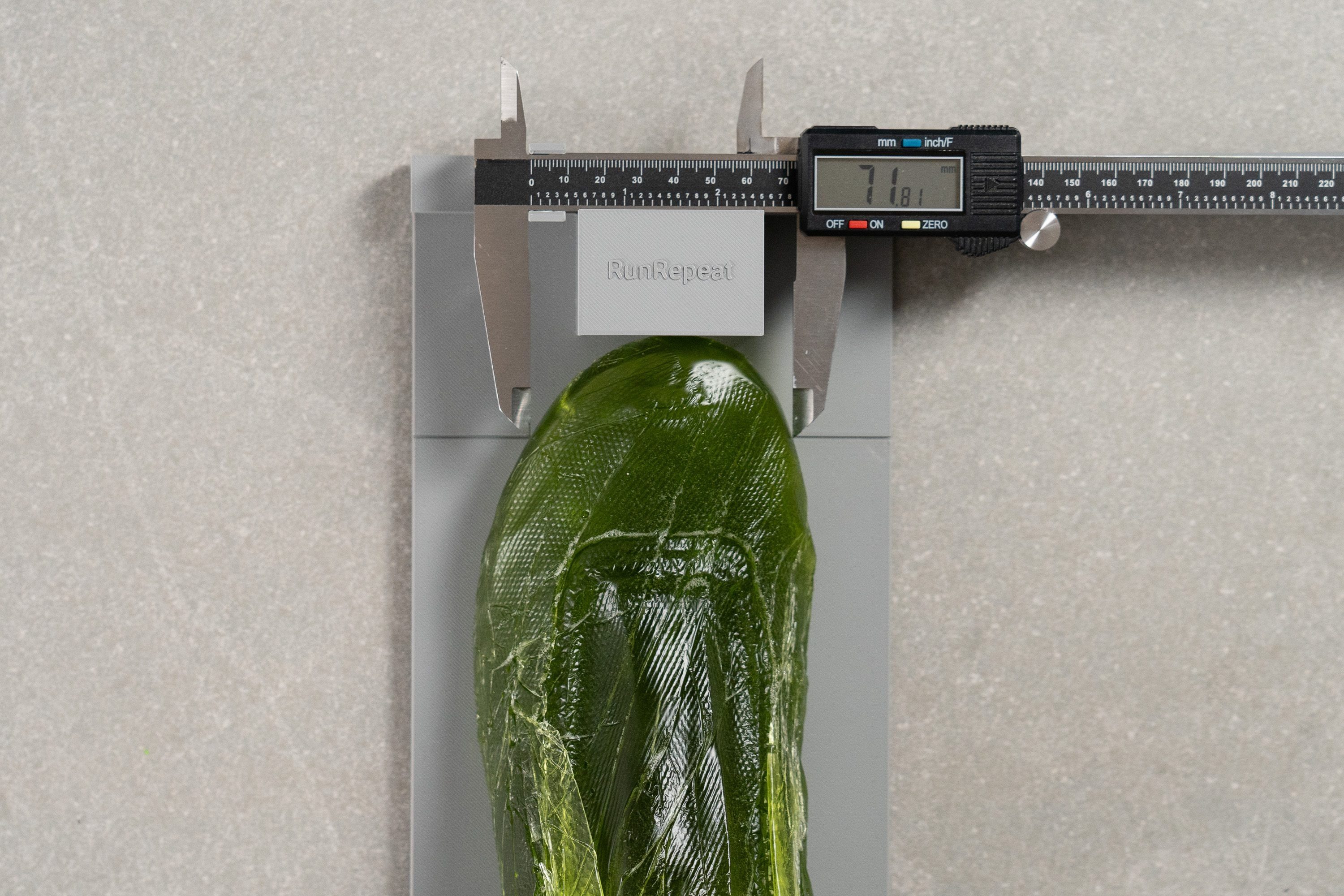
The width of the toebox at the big toe often has a bigger value for hikers with wider feet. With this knowledge, you’re equipped with a selection of hiking shoes that actually have wider toeboxes:
Keep in mind, though, that just like with other footwear types, some upper materials are stretchy and offer more give. Others can be very stiff, and overlays on the toebox can keep your pinky toe in a strict position with no room to splay, not even a little bit.
You may also be interested to know the height of the toebox, especially if you're prone to black toenails or bleeding toes. To avoid the pressure coming from the top, we suggest looking for toeboxes with more vertical space.
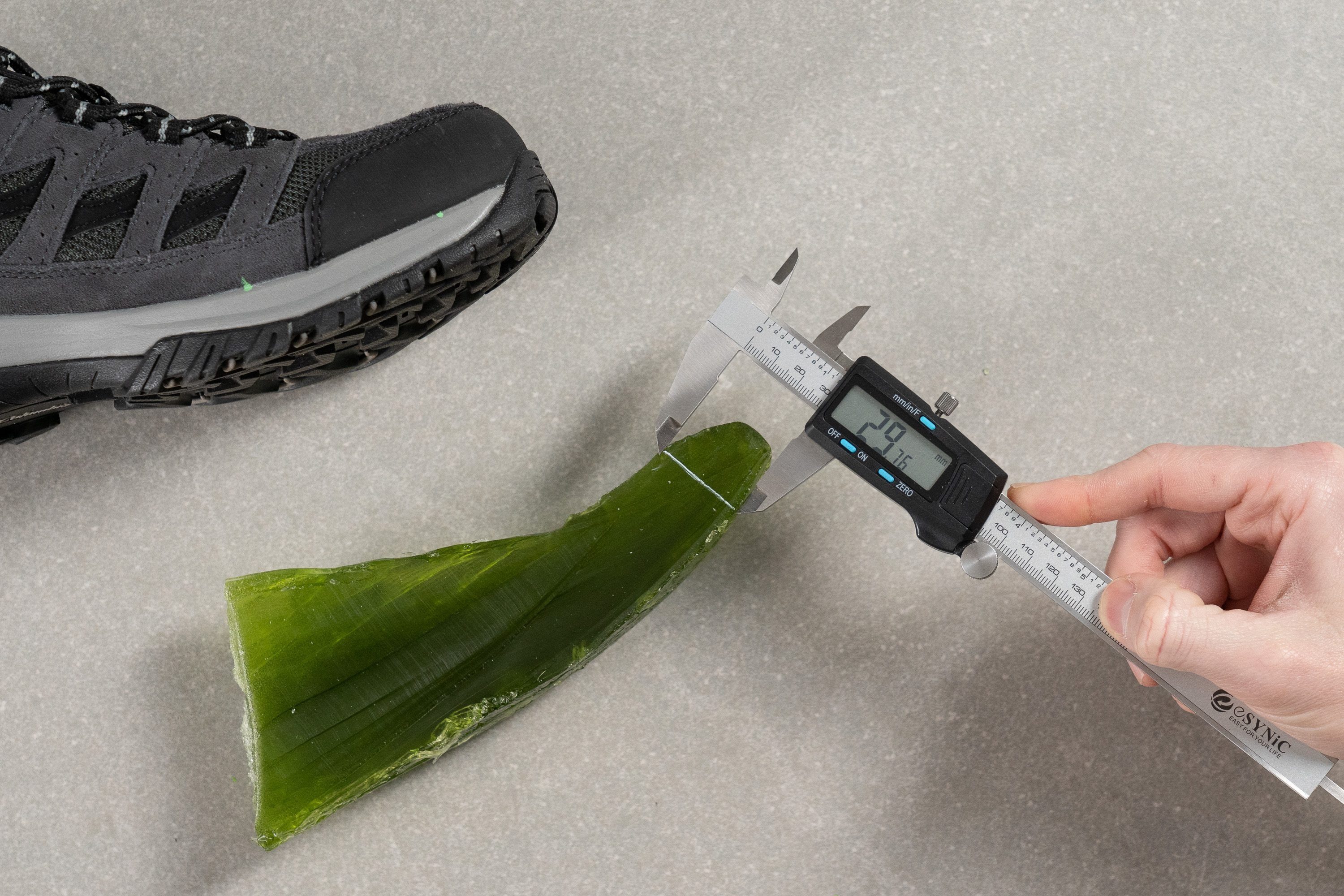
If focusing purely on the brand's labels, here's what to look for, depending on the gender:
|
Men |
Women |
|
|
Narrow |
B |
2A |
|
Medium/Standard |
D |
B |
|
Wide |
2E |
D |
|
Extra wide |
4E |
2E |
These labels are not the same because men's and women's feet are not the same; women tend to have narrower heels and wider forefeet.
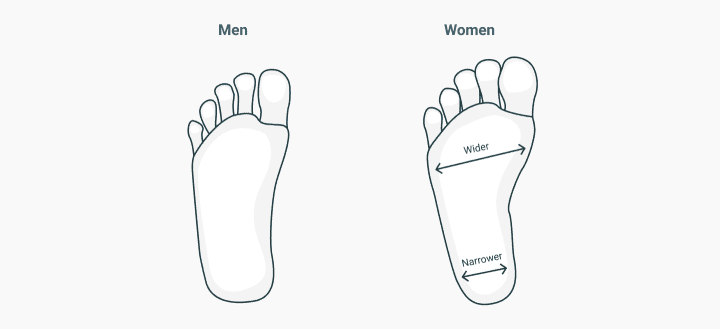
We wrote an in-depth guide on hiking shoes for wide feet in case you want to go into that direction.
6 steps for finding the perfect fit
Knowing your foot type makes a whole lot of difference. Aside from gauging if your feet are wide or narrow, if your feet have any special needs, make sure to treat them well.
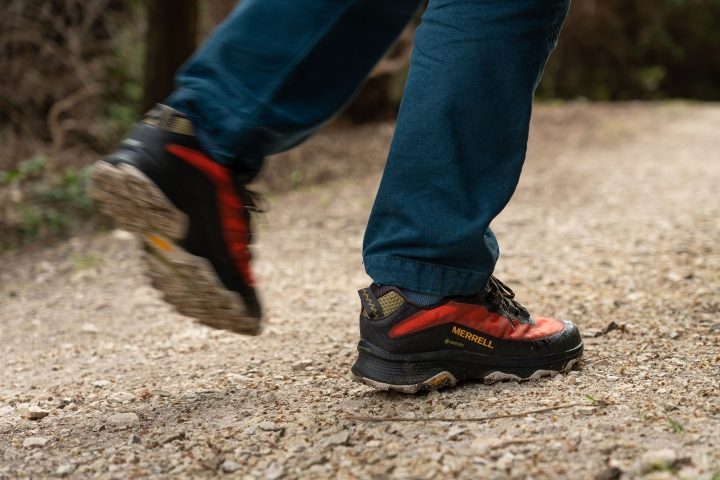
If you use orthotics, look for hiking shoes with a removable insole. Or, in case you are overpronating significantly or have plantar fasciitis, get the appropriate shoes that will not irritate your feet.
Here are the 6 steps to follow if you’re new to buying hiking shoes:
- Go shoe shopping in the afternoon. Expect your feet to swell after a day of activities. The same thing happens when hiking. So, it’s best to try on those new hikers late in the afternoon to get the best fit.
- Try it on, lace it up, and check for pressure points. There should be a thumb’s width space between your toes and the front of your shoes. If your feet move from side to side, then the hiking shoes are too wide. It should feel snug - comfortable and non-constricting.
- Make sure to try the shoes with your hiking socks on. Bring the socks that you plan to wear with your hikers when shoe shopping. Avoid using cotton since this type of fabric retains moisture and fails to provide insulation. Instead, choose wool or synthetic socks.
- Take your preferred insoles or orthotics with you. Default insoles often leave users disappointed. Aftermarket insoles or custom orthotics can greatly improve the fit of the shoe. If this fails, you can always try another pair from another brand.
- Use the ramp and walk up and down. This tests the shoe’s snugness. When you go up the board, observe for any heel lift. When you go down, check if your toes hit the front of the shoes. If your heel rises more than a quarter of an inch or if your toes hit the front, adjust the laces or try sizing up.
- Make sure to break in your shoes before your trip. Hiking shoes, especially the heavy, leather ones, require a different break-in time. Start small by wearing the shoes inside your house with your preferred socks. This might feel awkward but in the end, your feet will surely thank you). From there, increase your miles gradually.
Hiking shoe upper materials: mesh or leather?
We usually see hiking shoes with uppers made of synthetic mesh or leather.
Synthetic uppers are breathable, they dry quickly and weigh less. They also feel soft right out of the box.

The downside of having a mesh upper in hiking shoes is that they are less durable than the leather ones and they get soaked easily. Also, not a lot of support comes with the mesh uppers so we usually see them in shoes that are meant for (fast and) light hiking.
Leather (or suede, nubuck, full-grain) uppers are far more structured and supportive.
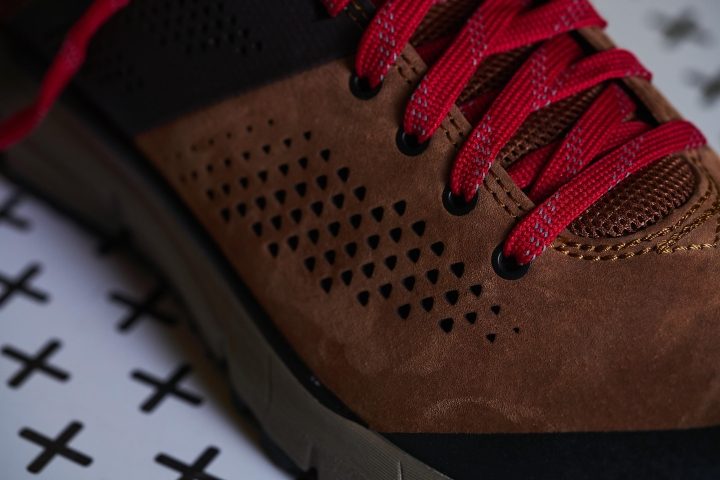
They are durable and warm. They even naturally repel water. However, they often ask for a break-in period and don’t breathe as well. Shoes with leather uppers weigh more.
Soft rubber or hard rubber outsoles: pros and cons
In our lab, after we’re done cutting the shoes in half, we measure the softness of the rubber with a Shore HC durometer. The lower the rating, the softer the rubber.
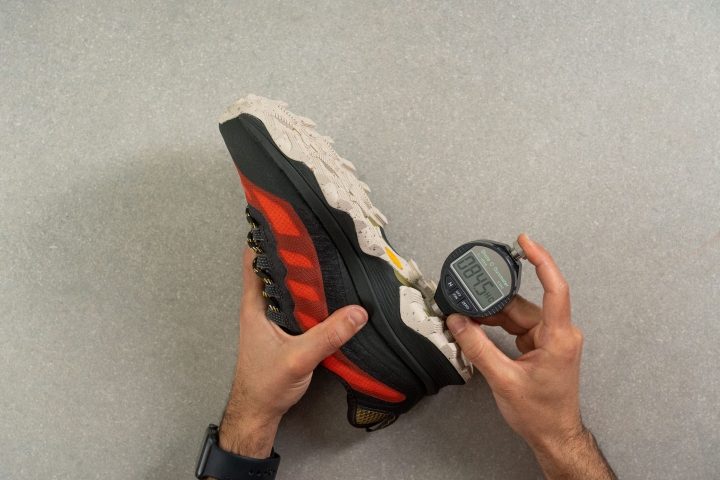
Softer rubber is better for deeper lugs and hiking in wet weather and on loose ground (like mud).
Softer rubber is more flexible and it’s stickier. Harder rubber, on the other hand, is more durable, stable and overall, more protective. However, it's not as flexible as the soft rubber. Harder rubber grips better on hard flatter surfaces, dry or wet. It offers more protection to our feet.
Get noticed in the dark
Some hiking shoes come with reflective elements. We love those as they make us more visible in low-visibility hikes and it’s easier to find shoes in a dark tent when all you have is a headlamp.
To check for these elements, we turn the light off in the lab and point the light at the shoes. See how great the KEEN Targhee III Waterproof looks in the dark!

